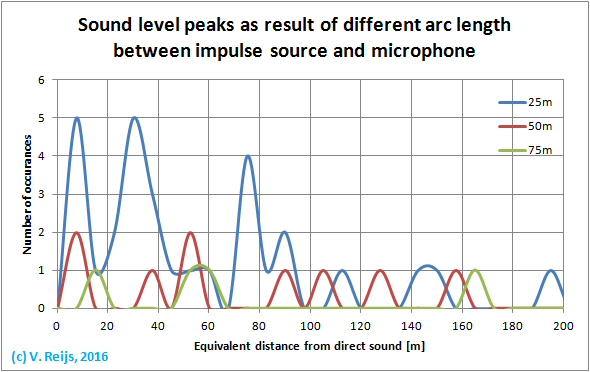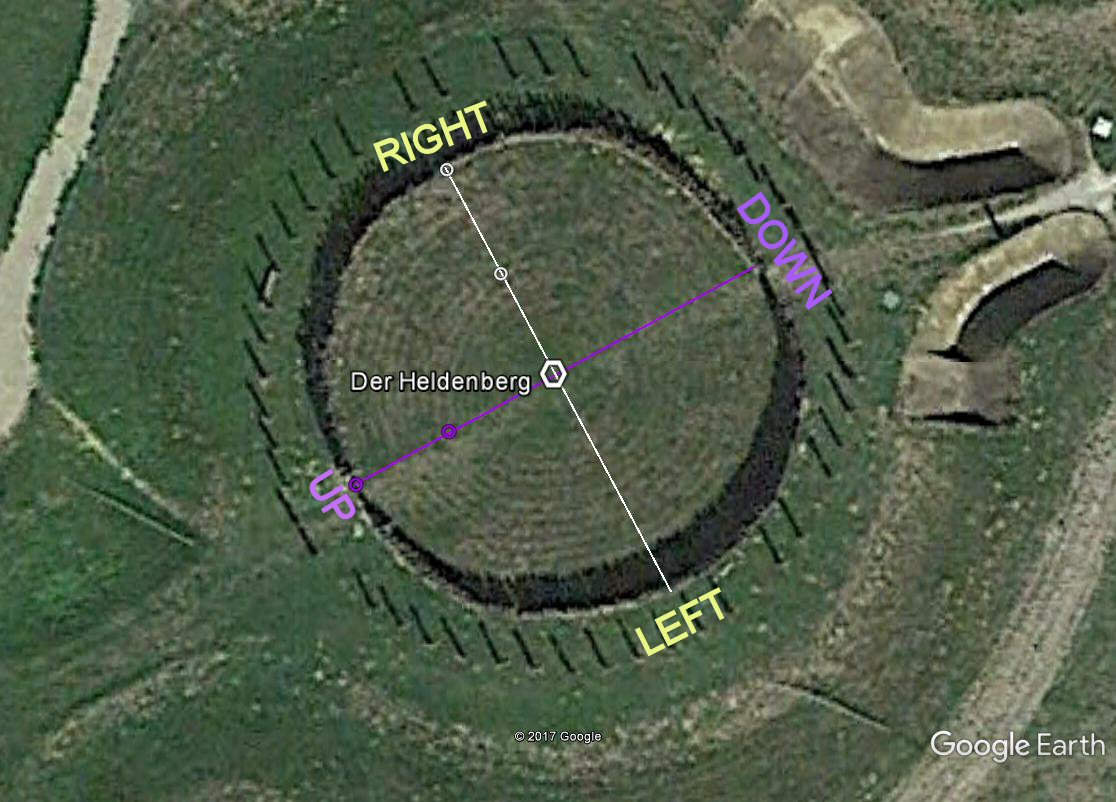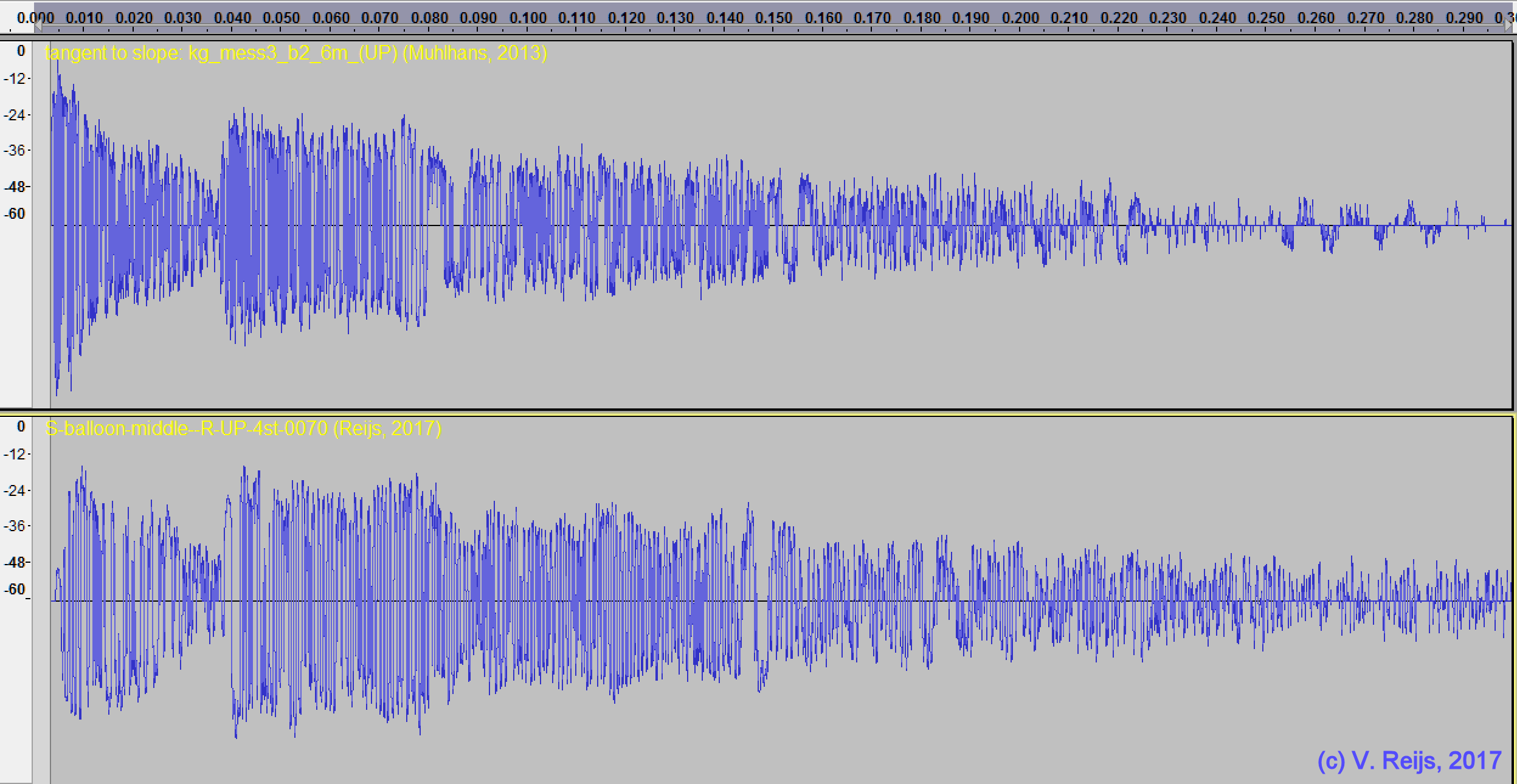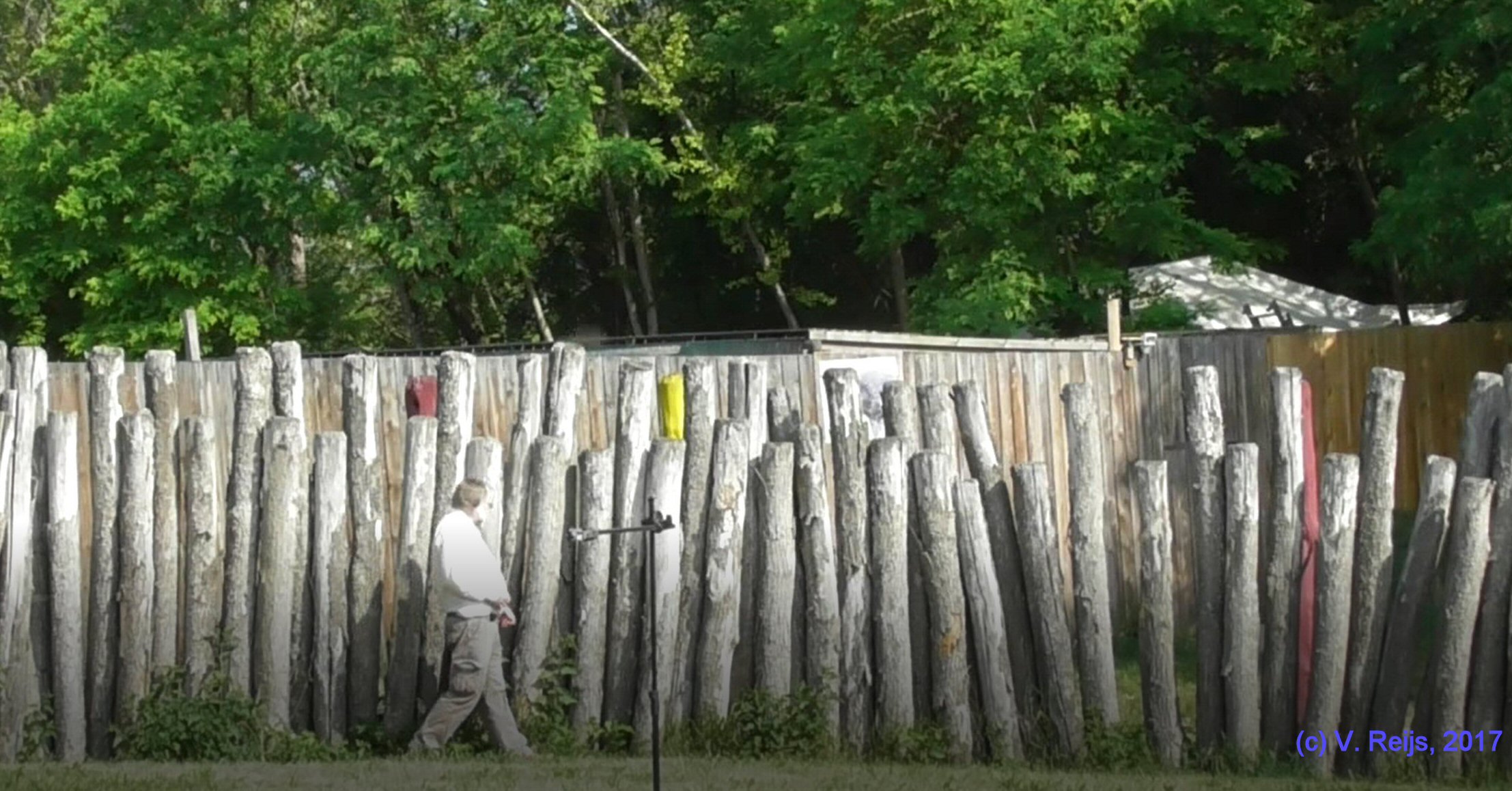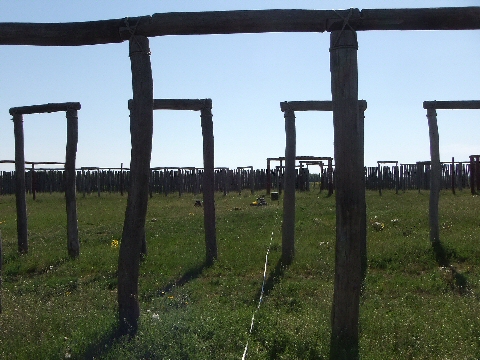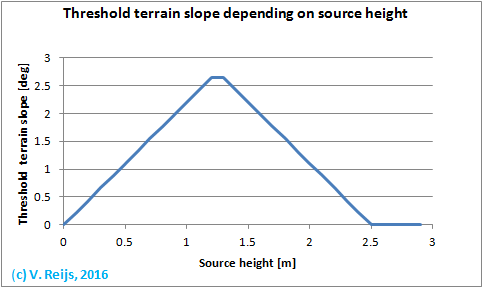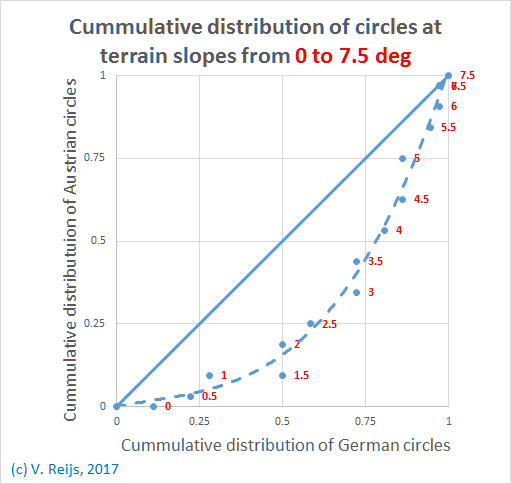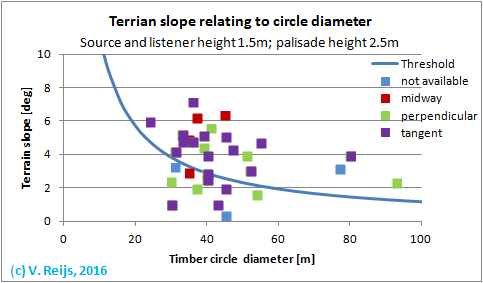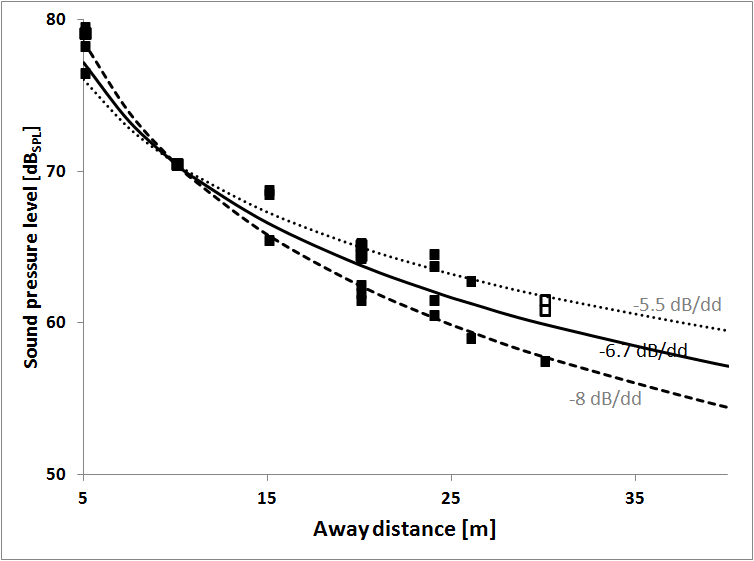Acoustic testplan and results from stone and timber circles
Please check the terminology section
for some defined words. The authors of this web site have visited
stone and timber circles some 15 days to make many acoustic
observations.
Content
The circles under
investigation
Three timber circles are investigated:
- Goseck, Germany
- Pömmelte-Zackmünde, Germany
- Heldenberg, Austria
Two stone circles:
- Dromagorteen stone circle, Kerry, Ireland
- Grange Circle B, Lough Gur, Ireland
One timber circle has not been investigated by ourselves, but is of
interest:
- Mansfeld, Germany
A few reference measurements were performed:
- a Home garden
- a few open fields (semi-anechoic space) in Goseck, Berlin and
Skerries
The dimensions of
circles
Goseck, Germany
Reconstructed Goseck
(from around 4800 BCE) has two tightly spaced (~4cm space between
them) (timber) palisade rings with diameter of ~52m (1st
palisade) and ~60m (2nd palisade). The posts have a
diameter of 20cm and a height of 2.5 to 3m. The posts are quite
straight and have no bark.
Weather conditions at Goseck are here.
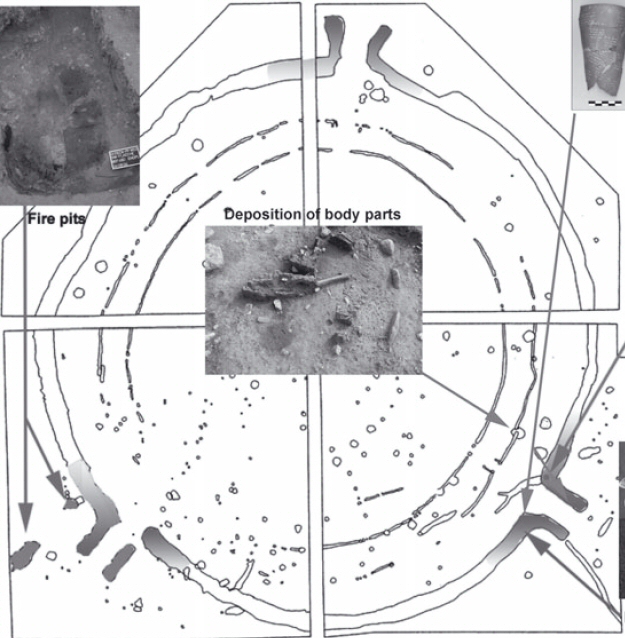
Goseck timber circle [Bertemes, 2010]
Pömmelte-Zackmünde, Germany
Reconstructed Pömmelte-Zackmünde
(from around 2300 BCE) has one tightly spaced (~4cm space between
them) (timber) palisade rings, one medium spaced (~20cm space
between palisade) and two widely spaced (~2m) (timber) palisade
rings. The diameter of the tightly spaced palisade are resp. ~75m
(1st palisade) and ~115m, while the two widely spaced
palisade are ~45 m and ~55 m in diameter. The posts have a
diameter of 20cm and a height of 2.5 to 3m. The posts are a little
bit crooked and have no bark.
Weather conditions at Pömmelte-Zackmünde are here.
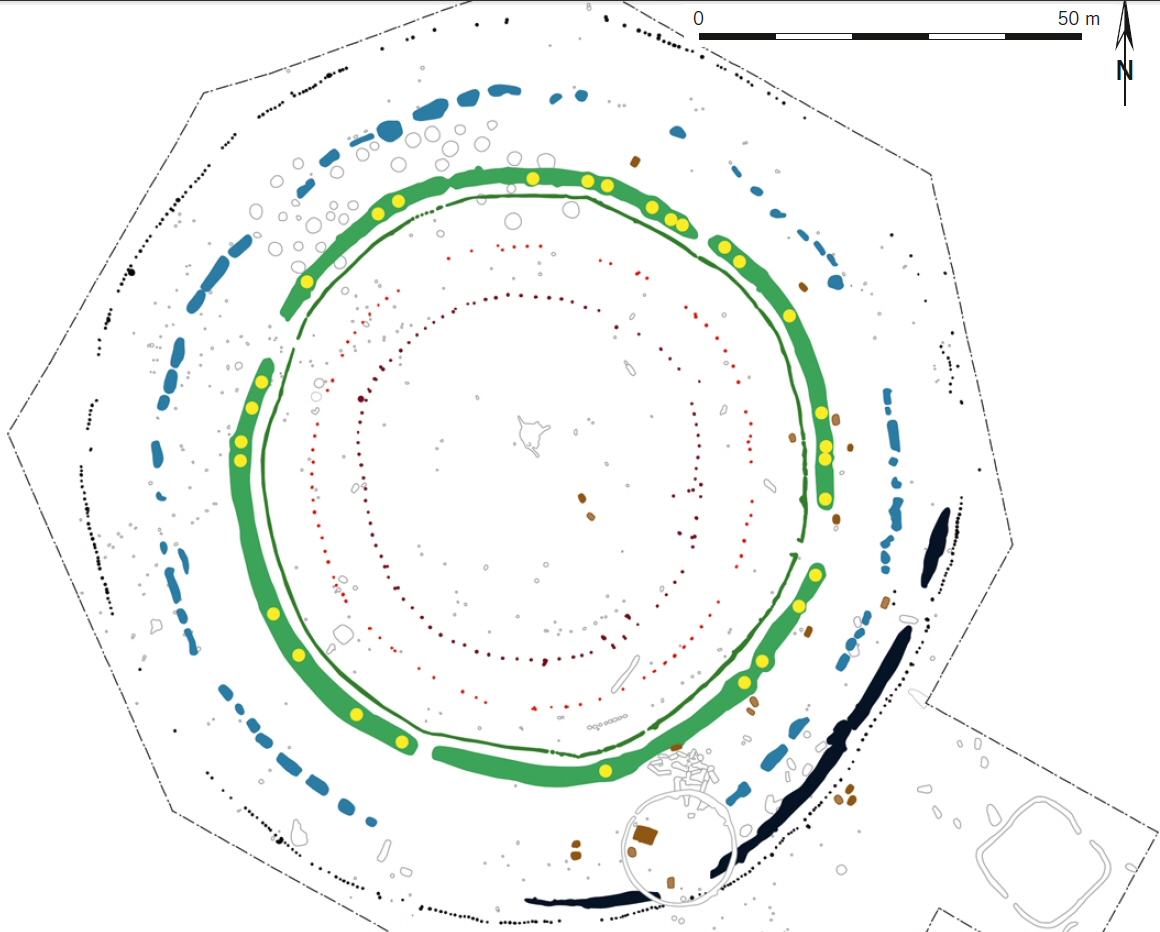
Pömmelte-Zackmünde timber circle [Spatzier, 2012]
Grange Circle B, Ireland
The Grange Circle
B at Lough Gur (from around 2900 BCE [Prendergast,
2016]) has an internal diameter of around 45.5m and its
standing stones are on average slightly higher than 1.5m
(some are though higher). There is an earthen bank (~ 9m wide and
~1m high on the inside and ~2m on the outside) along the standing
stones (on outside).
Weather conditions at Grange Circle B are here.
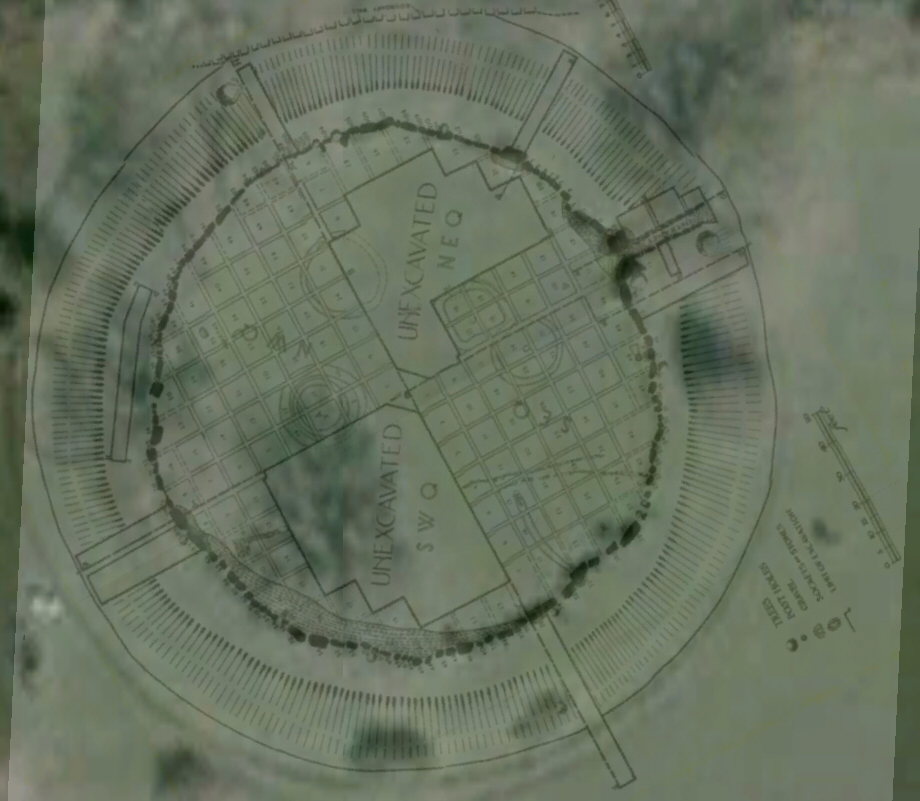 Grange Circle B [Ó Ríordáin, 1951
(adjusted to True North) and Google Earth]
Grange Circle B [Ó Ríordáin, 1951
(adjusted to True North) and Google Earth]
Dromagorteen
stone circle (Early/Middle Bronze Age: 2000 to 1150 BCE),
situated in the Bonane Heritage park, is of the type of Axial
Stone Circle (ASC) with 13 stones. The circle has a diameter of
around 10 m. This one might be too small to be compared with
others.
Weather conditions at Dromagorteen are
here.
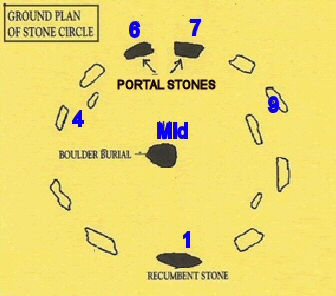
Dromagorteen stone circle [after Bonane Heritage park, 2010]
Mansfeld, Germany
Mansfeld
at the former Am Archäopark, which is a reconstruction of
Schalkenburg,
Quenstedt (from around 4800 BCE), has a 1
st
palisade with an short axis of 35m and a long axis of around
44m. Its 5
th palisade is around 90m by 120m. The
reconstruction though has deteriorated so much in the last years
(at least from 2005 on) that it is not presentative anymore. The
posts had a diameter of ~27cm and a height of 2 to 3m. The posts
were quite crooked and many had (peeling) bark. Mansfeld is
build on a sloping terrain: the north east of Mansfeld is some
2m lower than the south west corner of the 1
st
palisade (around 2.5deg). Quenstedt was build at the top of a
hill [Kaufmann, 2011, page 109]. Quenstedt might have had
tightly-spaced double palisade palisades (like Heldenberg)
[Kaufmann, 2011, page 107].
Weather conditions at Mansfeld are
here.
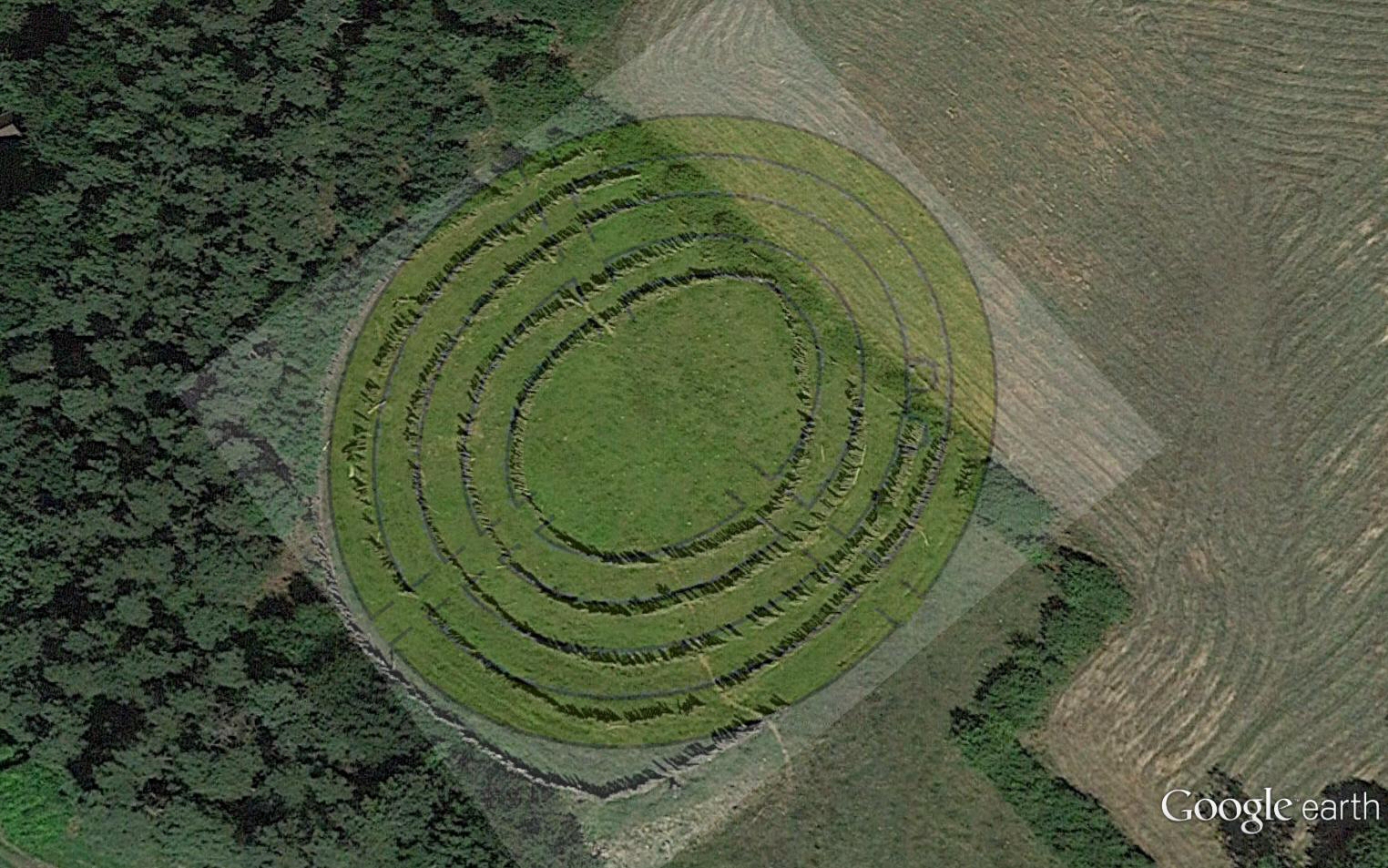
Mansfeld reconstruction from Quenstedt
[Google Earth, 2009; Wikipedia]
Heldenberg, which is a reconstruction of
Schletz
timber circle, Austria (from around 4850 to 2550 BCE,
so similar to some of the Central Germany circles; like
Goseck), has two tightly-spaced palisade circles one
with an axis of ~24m and the other one somewhat larger
(~24.3m); and one widely (~1.5m) spaced palisade (~30m
diameter). The tightly-spaced double palisades have gaps
between posts of ~10cm. Seen from the centre, there are no
gaps; posts of 2
nd palisade are shifted somewhat
relative to the 1
st palisade. The posts have a
diameter of ~25cm and a height of 2.8 to 3.2m. The posts are
straight. Bark is still on them (no peeling bark, at least
in 2013). Heldenberg is on a terrain slope of around 4.5 deg
(Google Earth showed 5 deg).
Scheltz looks also to be on a slight ridge and thus on a
sloping terrain (around 6 deg).
Re-reconstructed
Heldenberg
The circles was re-reconstructed (in 2016), after the posts
had rotted after the initial construction (13 years ago).
The height of the posts on the inside of the palisades were
on average ~1.9m while the posts on the outer side of the
palisade were on average ~2.3m. This is some 0.9m lower than
the initial reconstruction. The posts are still barked, but
were loosing their bark. There were at some places
considerable gaps between the posts.
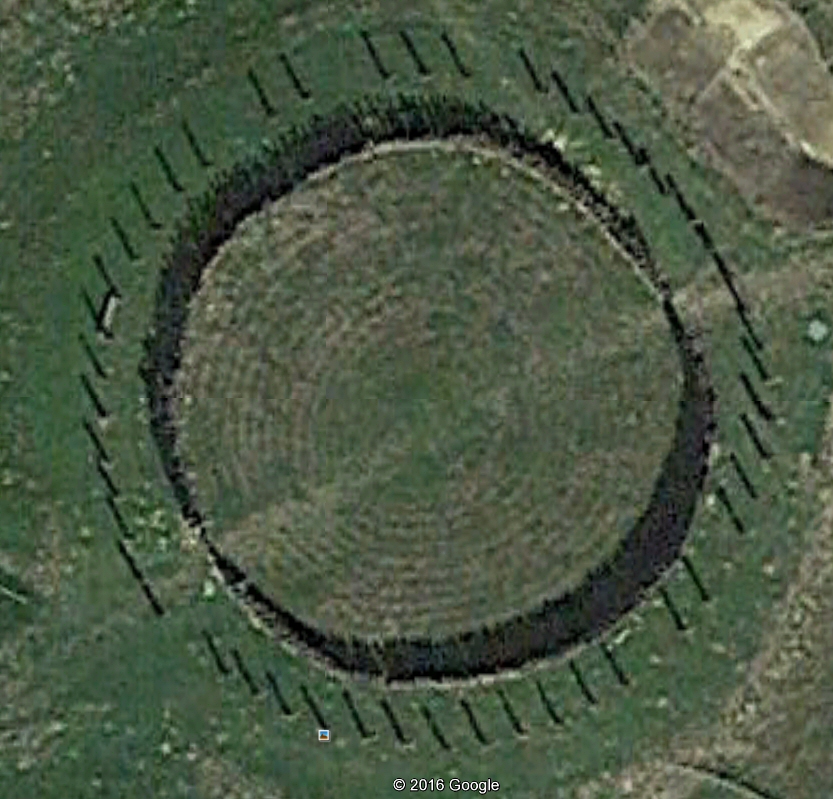 Heldenberg reconstruction from Schletz [Google Earth,
2016]
Heldenberg reconstruction from Schletz [Google Earth,
2016]
Archaeoastronomy
Goseck
Likely winter solstice and summer solstice Sun rise/set, Beltane
and Lughnasadh Sun rise/set
.
Pömmelte-Zackmünde
Likely Imbolc
and Samhain Sun rise.
Grange Circle B
Likely Beltane and Lughnasadh Sun rise.
Dromagorteen
Likely summer solstice Sun rise and major lunar standstill
limit event rise.
Likely summer solstice Sun rise/set and winter solstice Sun
rise.
Schletz
A study on the archaoeastronomy of Austrian timber circles
has been done as part of the ASTROSIM project
[ASTROSIM]. The results are meager for the 32 Austrian KGAs
investigate. No significant astronomical evident has been
found for the positioning of entrances, it looks that
entrances of the Austrian KGAs are positioned by looking at
the lay of the land [Zotti, 2011].
Measurement methodologies
Room based acoustic measurements (see for instance [Ahnert])
might not be very effective in these large open space. Perhaps
music-hall methodologies are more important. Perceptions of
effects are just as important as measurements. There look to be
three different measures:
- objective, purely based on measurements
- subjective
- psychoacoustic; including the effects of the human receptors
and the brain
- cultural; what cultural recognises and defines as good or
bad
The following type of measurements/observations could be done (bold
measurements have been assessed at the circles):
- sensing and mapping space: archaeography
sound source: none
applicable freq. range: all
[Graves, 2009; Blesser, 2007, 37-51]
- draw-away measurements
sound source: noise, speech and music sounds
applicable freq. range: all; for whispering gallery: high freq.
determine the sound attenuation while varying the distance
[Toole, 2013, chapter 4]. This will also result in the Strength
G (at 10m from sound source) when compared to the monument and
open field [Campanini, 2009] [Parker, 2013]
Look also at the sound pressure level decay: inverse square law
(open space), inverse of distance (whispering
gallery wave; sound
diffraction), or focal points.
- apparent source widening (ASW: sound stage
illusions)
sound source: noise/impulse sounds
applicable freq. range: > 500 Hz
this is due to reflections within ~80ms (Haas/Precedence-effect)
(if RTT<80ms; distance listener and palisade < 14 m)
[Toole, 2013, chapter 7]
- listener envelopment (LEV: surround illusions)
sound source: noise/impulse sounds
applicable freq. range: < 500 Hz
this is due to reflections beyond ~ 80ms (if RTT>80ms;
distance listener and palisade > 14 m) [Toole, 2013, chapter
7].
- discrete echoes (second image)
sound source: impulse sounds
applicable freq. range: all
Experiencing discrete echoes in a time frame larger than (40 to)
80ms [Everest, 2001]. Related to reverberation time: T60 and
EDT.
- increased Preference
(using IACC [binaural])
sound source: noise/impulse sounds
applicable freq. range: all
a change that might be perceivable for reflections larger than
10ms (if RTT>10ms, distance listener and palisade > 1.7 m)
[Toole, 2013, chapter 7]
- timbre changes
sound source: noise/impulse sounds
applicable freq. range: all
Other words for this: coloration. Can be due to resonance,
filtering and/or comb effects.
- clarity of music (C50, [Bradley,
2011])
sound source: impulse sounds
applicable freq. range: 500, 1000, 2000 and 4000 Hz
- clarity of speech (C80, [Bradley,
2011])
sound source: impulse sounds
applicable freq. range: 500, 1000 and 2000 Hz
- chirp echo
sound source: impulse sounds
applicable freq. range: all
acoustic convolution-scattering might happen when making impulse
near the palisade. [Toole, 2013, section 6.5] [Lubman, 1998,
including sound file and Lubman, 2008]
- directivity of the sound (using binaural measurements)
sound source: noise sounds
applicable freq. range: > 500 Hz
[Toole, 2013, chapter 6]
- resonances can happen in timber circle
sound source: special sounds
applicable freq. range: < 500 Hz
The diameter is 50m or longer so the first mode would be around
3 Hz. Not really something to observe/perceive or measure with
available equipment, IMHO.
[Toole, 2013, chapter 4.3]
- word clarity
sound source: speech sounds
applicable freq. range: all
[Mallinger, 2011], [Toole, 2013, page 167]
Considerations for locations of the measurements:
- at places that could have acoustic differences, such as: wide
or thin openings/entrances; in center; focal points of ellipses;
close to palisade; on boundaries of 1.7m and 14m from the
palisade; at archaeological important locations (burial pits);
within palisades; between palisades; and outside palisades.
- if the monument is symmetric, only measurements on one of the
symmetrical sides is needed
- make sure that the sound source covers the whole area (as much
as possible)
- take similar measurements at similar distance in open field
Sound sources
The following sound sources were considered (bold means
that they were used during the experiments):
- Noise sounds
- Speech sounds
- Special sounds (on computer)
- Music sounds
- Impulse sounds
Equipment list
The following equipment was used during the investigations:
- Power
- 12VDC car battery 60 or 80 Ah (RM)
- car battery charger 6 to 10 A (RM)
- 12VDC to 220VAC inverter 1200W (VR)
- 150 m power extension lead (RM)
- opened power closets at timber circles (RM)
- at least a 3-way extension lead with type C or F sockets
(220VAC) (RM)
- batteries for any other equipment (VR)
- Sound sources
- sound system (2*50W) and 2 speakers (2*75/100W) (RM). Could
only be used upto volume value 30 (the audio power is not
measured/known).
- balloons (45cm from tip to mouth piece in blown state, which
is approximately a diameter of 24cm) plus pin to pop on the
balloon's side (RM)
- bull roarer (VR)
- shamanic drum (RM)
- bodhran (VR)
- CD with noise, speech and music sounds (each 15 mins) long
(RM)
- USB flash drive with 20 sessions of 20 words to determine
word clarity (RM)
- spare micro SD cards and spare CD with noise, speech and
music sounds (each around 10min long); they are also on the
shared dropbox directory: \Soundtest 09.04.2016\CDsounds (VR)
- small
(flag based on A4) and large (based on a little larger than
A3) paper bangers (several as they will break) (VR)
- Bluetooth stereo speaker (2*8W RMS) (VR) and 30W (FH)
- Recording
- two omni directional microphones (VR)
- binaural microphones (VR)
- wind muffler (VR)
- microphone boom (VR)
- headset (VR)
- Zoom H1 recorder plus spare battery (VR)
- SPL sound meter plus spare battery (VR)
- word clarity questionnaire (RM)
- Audio cabling and tools
- collection of connectors (3.5 mm, RCA, male, female, etc.)
(VR)
- collection of RCA cables (VR)
- some tools (screwdriver, isolation tape, multi meter, zip
tie straps, etc.) (VR)
- paper note books (VR, RM)
- camping table and folding chairs (to put sound system on)
(RM)
- bin liners (RM)
- tape measure 100m plus tent peg (RM)
- Analytics and resources
- laptop plus charger (VR)
- RPlusD, Audacity and Aurora software (VR)
- Sound level, Hi-Q MP3 recorder, Geosurvey and SunSurveyor
Apps (VR)
- relevant books, literature. (VR, RM)
- liability insurance (VR, RM)
Questionnaire
A questionnaire has been made for Goseck on SurveyMonkey.
If you want to provide input, please do.
Participant
Victor Reijs
Date
|
Location
|
Wind Speed [km/h]
|
Wind direction
|
Beaufort
|
Temp [oC]
|
Air pressure
[mbar]
|
Sound
speed
[m/sec]
|
Humidity [%]
|
14/11/2015
|
Dromagorteen |
~10
|
WSW
|
high 2
|
~16
|
1009
|
~341
|
~82
|
15/11/2015
|
Dromagorteen |
~10
|
SW
|
high 2
|
~13
|
1005
|
~339
|
~88
|
Equipment
The microphone (Zoom
H1 recorder) was on top of the recumbent stone (Stone1) some
0.8 m high and the sources (balloon, paper
banger) were at around 1.2 m high.
Measurements
In below figure is an example of the popping of a small balloon
between the two portal stones (Stone 6 and
Stone7). You can see power peaks around:
- 3 msec
traveled an extra 1 m, which could reflection against some stone
near the portal stones or Stone1
- 12 msec
traveled an extra 4 m, which could be a reflection from Stone4
or Stone9 to Stone1
- 33 msec
traveled an extra 11 m, which could be a reflection from Stone1,
MidStone and back to Stone1.

Impulse response from small balloon
The above ETC graphs are made by the Aurora
module for Audacity
2.0.0.
Binaural recording
One binaural recording (with paper banger impulse from near Stone 1)
was made.
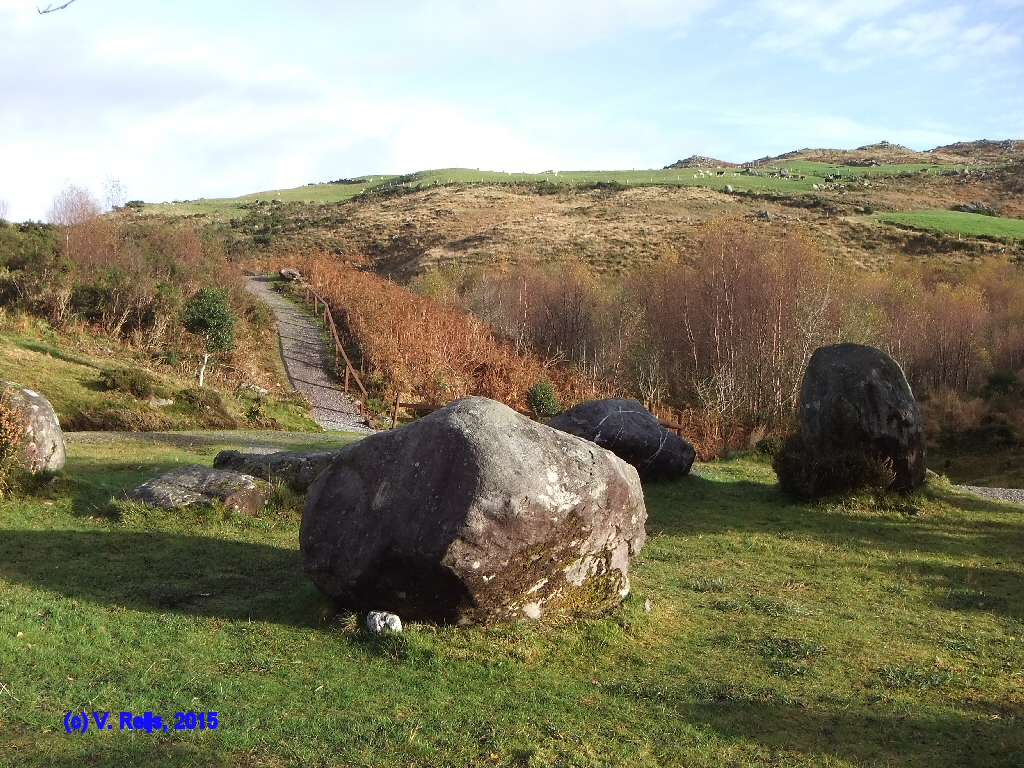 Sloping hill on the north-west side of the stone circle
Sloping hill on the north-west side of the stone circle
The below graph gives the power levels at Stone1. At ~0.7sec, around
a distance of 145m from source, there is this rise in the terrain
(in summer solstice sunrise direction).
 Impulse response at Stone 1, by paper banger
Impulse response at Stone 1, by paper banger
Perceptions
- On the above binaural recording a kind of scanning reflection
can be perceived, unfortunately a repeat impulse sound did not
show this, but the angle/direction of the impulse sound could
have been different.
Lessons learnt
- record at least at 24 bits and 48 kHz. And save the correct
format to keep that 24bits and 48 kHz (in Audacity: File ->
Export -> Save as type: 'Other uncompressed files' ->
Options... -> Encoding: 'Signed 24-bit PCM' -> OK ->
Save.
- Manipulate the IR the least possible. If one saves an IR, use
enough trailing length; the clips at least three the length of
the RT60.
- test all equipment before going into the field. In the field
it is sometimes very difficult to debug problems and to
implement a solution.
- be sure one has plan B ideas/equipment/batteries/etc. in case
plan A does not work.
Observations in Home
garden
Participant
Victor Reijs
Binaural recording
A binaural microphone recording has been done by walking through the
Home garden while recording a video and tracking the location. A
composite video is available here (it is
important to have a stereo headset to appreciate the binaural
effects).
Draw away measurements (loudness)
The question is: Would a 50W amplifier provide enough power for
sound level measurements in open space aka timber circles?
An amplifier (Panasonic SG-HM-10L) was put at the top of a Home
garden (where the house is). The walled garden is rectangular (~8m
wide and ~15m deep) and its walls are covered with trees/bushes.
There is though a glass conservatory for the first 4m. Brown noise
was played and the audio power was around 10W.
The sound level in dBSPL was measured while drawing
away from the sound source, see below picture.
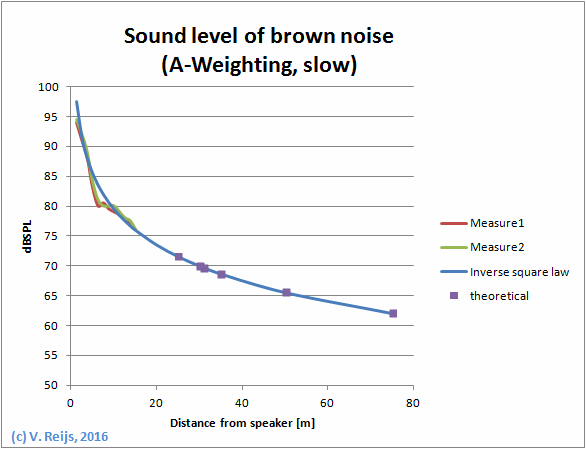
Sound level of brown noise
The dip around 5m could be due to the shadow-reflections from the
conservatory.
There is some 4 dB between the power at 20m
and 31m (to be compared to Grange Circle B) and there is some 2dB
between the power at 25m and 30m (to be compared to Goseck).
Lessons learnt
As the sound level of 'silence' was around 50dBSPL,
one would need at least some 20 dB above that for kind of accurate
results. If the inverse square law holds, that would only give a
maximum distance of ~30m at 10W. If we increase the
amplifier output to 50W (aka 6 dB more than 10W), the sound would
reach a distance of some 60m. This is comparable to the diameter
of the timber circles. So 50W amplifier looks to be just good
enough.
Pre-test in early April, 2016
Participants
Reinhard Mussik, Finn Hockauf and Elke Hockauf
Test plan for Goseck and Pömmelte-Zackmünde
Measurements done, to get a feel of the timber circles, are
around:
- Determine how far a 3W bluetooth speaker comes (please
record/note: sound, location, condition and other things)
- Get a feel how the different (music and impulse) sounds work
(please record/note: sound, location, condition and other
things)
- Determine if there are obvious acoustical effects (like:
gain, reflections, echoes [second image] and chirp echoes) at
certain locations (center, entrances, inside two palisades, near
palisade, outside palisade , etc.) (please record/note: sound,
location, condition and other things)
- Determine how close we can park and power closet.
- Determine if there are people living nearby who would want to
know that we are working in evening/night at the timber circle
- Perhaps meet with collaborators.
The quality of the recording was not essential, but noting
experiences/perceptions where possible effects can happen, helped us
to direct our attention for our May visit.
Date
|
Location
|
Wind speed [km/h]
|
Wind direction
|
Beaufort
|
Temp [oC]
|
Air pressure
[mbar]
|
Sound
speed
[m/sec]
|
Humidity [%]
|
9/4/2016
|
Goseck |
~12
|
NE
|
low 3
|
~12
|
1010
|
~338
|
~55
|
10/4/2016
|
Pömmelte-Zackmünde |
~18
|
SE
|
high 3
|
~12
|
1014
|
~338
|
~60
|
Goseck
Equipment
Impulse sound source: balloons ~45 cm (when blown up)
Music sound source: 3W loudspeaker
The microphone (Samsung Galaxy S5,
not in flight-mode) and the sound sources were at around 1.2 m
high.
No wind muffler was used.
Measurements and results
Several measurements were done. One was with the impulse sound
(balloon) at the centre (X) and the Observer (O) 1 m from the inner
palisade (the inset of below picture gives idea where the X and O
are). In the below picture also the impulse response (IR) at
location O has be shown (the wiggly sound graph). Furthermore you
can see several dots (blue, orange, red) near the time line, these
are determined by using a computer model for predicting the IR. As
can been seen the computer model maps well the actual peaks (as
there is periodicy: flutter echoes) in the response (although
multiple peaks from 5*A-O are not all predicted by the computer
model).
An animation can also be seen here.
Other measurements done can be predicted somewhat by the dimensions
of the two palisades and the locations of X and O. It looks that
Precedence, ASW and LEV effects can occur.
There is a timbre difference when O is being inside, between and
outside the palisades.
Draw-off measurements did not work as the power of the music sound
source (3W CD player) was not enough. This was known, as we did not
have 240 VAC available for the pre-test.
No focal points were experienced by listening with the ears.
Due to overload of the microphone we could not measure the power
difference just within the 1st palisades and just outside the 2nd
palisade.
When X and O are around 1m from the inner palisade, a chirp echo has been observed.
Perceptions
-
The echoes (second image) were clearly audible. Also other
visitors told us that they heard echoes.
- It was possible to speak with people in the inner circle at
normal volume, regardless of the position of the speaker and the
listener.
-
The music from the 3W loudspeaker was well audible in the
whole inner circle, regardless of the position of the
loudspeaker and the listener. But it was not every time
recorded by the smartphone mic.
Lessons learnt
- balloons with blown dimension of around 45cm (tip to mouth
pice) work well
- have phones in flight mode to minimise interference noises
- handle the recording device with care, before the IR and after
the IR, to minimise handle noises.
- use a wind muffler
- make sure the start of the IR does not peak to the max (so
keep the level in mind).
- have enough sound source power
- better to take the measurement in the early morning because of
the less: wind (and thus wind noise), tractors, airplanes and
visitors.
Pömmelte-Zackmünde
Equipment
Impulse sound source: balloons ~45 cm (from top to month piece)
Music sound source: 3W loudspeaker
The microphone (Samsung Galaxy S5,
in flight-mode) and the sound sources were at around 1.2 m high.
No wind muffler was used.
Measurements and results
Draw-off measurements did not work, as sound levels were not easy to
measure from recordings.
Focal points were experienced by listening with the ears (and after
that recognisable on recordings).
When X and O are around 1m from the inner palisade, no explicit
chirp echo has been observed. There might be some though...
Perceptions
- There were echoes (second image) in Pömmelte-Zackmünde, but
not so powerful as in Goseck (see also below Spatzier's comment when the
reconstruction was done).
- It was possible to speak with people in the inner circle in a
loud voice. The quality depended on the position of the speaker
and the listener.
- The music from the 3W
loudspeaker was audible in the whole inner circle. But the
sound quality depended of the position of the loudspeaker and
the listener.
- When the loudspeaker and the
listener were both at a distance of 2.5 m from the centre of the circle (possible focal
points), the sound quality was the best. This could not be
repeated during the next visit (May 2016).
Lessons learnt
- having phones in flight mode really works
- handling the recording device with care really reduces the
noise
- have sound level meter, instead of recordings for determining
draw-off values
Participant
Victor Reijs
Weather data
Date
|
Location
|
Wind speed [km/h]
|
Wind direction
|
Beaufort
|
Temp [oC]
|
Air pressure
[mbar]
|
Sound
speed
[m/sec]
|
Humidity [%]
|
25/4/2016
|
Grange |
~18
|
W
|
high 3
|
~7
|
1022
|
~335
|
~90
|
26/4/2016
|
Grange |
~13
|
NW
|
low 3
|
~5
|
1018
|
~334
|
~70
|
27/4/2016
|
Grange |
~12
|
NW
|
low 3
|
~1
|
1019
|
~332
|
~87
|
Equipment
- Zoom H1 plus wind muffler and binaural microphones, microphone
boom
- large paper banger
- 2*1W CD player
- CD with sounds (brown, pink noise, babble, Bronze Age Horn,
whispering)
- claves
- balloons (15 and 10cm diameter)
Measurements
- draw-away measurements, inside and outside circle
- determine if a kind of chirp echo or whispering gallery effect
happens.
- stress test the large paper banger
Results
- It looks that the draw-away power does not show focal points
(at least not within 10 m range of the Rannach Crom Dubh).
- Cassidy [2016] shows reflection timings similar to my own
(following distance and speed of sound).
- If the mic is 10m from the centre
(where the paper banger is) in direction of Rannach Crom
Dubh; the direct sound has less power (on average some
2dB) than the reflection from Rannach Crom Dubh (see
below graph). This can also be clearly heard in the auralisation.

Rannach Crom Dubh has a slightly titled angle [Cassidy,
2016, page 117]; so could this higher power be due to this
slightly titled angle?
The sound level of the reflection compared to the direct sound
at different distances from the centre can be seen in below
table and this graph (green
squares): All these reflections are heard as second
images.
Location from
centre [m]
|
Reflection time
[msec]
|
Reflection-Direct
sound level [dB]
|
5
|
103
|
-7
|
10
|
70
|
2
|
15
|
38
|
10
|
- The reflection from Rannach Crom Dubh looks to be some
6 dB more powerful than the reflection from the standings stones
near the passage. If no large standing stones are present, there
is no real reflection.
- When recording 10m from the two stones shaping a V opposite
the passage; beside the reflection of the paper banger from the
stones shaping a V (an additional ~24m); the reflection of Rannach
Crom Dubh (an additional ~ 45m); and also the reflection
from the standing stones near the passage is recorded (an
additional ~58m).

- no chirp echo effect was experienced.
- no whispering gallery effect was experienced (only the
reflection of the opposite side is seen when using large paper
banger at Rannach Crom Dubh).
- large paper banger lasted at least 60 bangs (using brown
packing paper).
Stone circle's bank as noise barrier
The sound level on top of the bank
is around 2dB lower than on the edge of the circle (~20m), while
several meters further (but 'behind' the bank at field level,
~31m) it is some 19dB lower than at edge of circle. Compare this
with the 4dB decrease in open air. Open air
sound is some 3 times (15dB)
louder then just behind the bank of Grange Circle B. The
bank is an effective barrier, see also this
section.
Perceptions
The following perceptions where made:
- Mickael Fenström experienced the following at Grange Circle B:
We found that the dominant
reflection is from the Rannach
Crom Dubh. Subjectively, the most
exciting thing we heard was when we had one person chanting
from the center of the circle towards Rannach Crom Dubh. When
standing on the bank, behind the chanting person, an
interesting ‘overdub’ effect could be heard. We speculated
that this could be used as a ‘voice of the gods’ effect.
This could be related to the on average
some 2 dB difference between direct sound and reflection
against Rannach Crom Dubh.
Although measurements need to be taken at the bank to determine
if the reflection is there still more powerful than the direct
sound (form the source in the centre).
- When standing beside Rannach Crom Dubh (or a tree or
other large stone that reached up to head height), sounds are
muffled due to the object and thus its shadow effects. It feels
like a pressure difference in the ear (or is it the sound
pressure difference between the two ears?).
- When walking from Rannach Crom Dubh to the centre, the
timbre is changing (due to Haas or comb effect) and some few
meters before reaching the centre the sounds is perceived to be
flatter.
Lessons learnt
- Include silence on the recording, to be able to reference
silence (or wind sounds...).
- Cars (~6dB above background), and to a lesser degrees bird
singing (~4dB above background) can cause considerable loss in
dynamic range of sound level measurements. Wind noises can start
to be detrimental from wind force 3 (certainly its gusts).
- The wind muffler used was not effective above low 3 force.
- It is important to have at least one or two spare paper
bangers!
- Check regularly that indeed the recorder is recording!
- Have something to put the loudspeaker at a higher level
(1.5m).
- Make sure one measures in open field the impulse sound at 10m
(for referencing to the strenGth parameter) and possible other
references to compare.
Test in May, 2016
Participants
Victor Reijs, Reinhard Mussik, Finn Hockauf and Elke Hockauf
Date
|
Location
|
Wind speed [km/h]
|
Wind direction
|
Beaufort
|
Temp [oC]
|
Air pressure
[mbar]
|
Sound
speed
[m/sec]
|
Humidity [%]
|
5/5/2016
|
Pömmelte-Zackmünde |
~13
|
NE
|
low 3
|
~14
|
1027
|
~339
|
~51
|
6/5/2016
|
Goseck |
~5
|
E
|
high 1
|
~12 to ~18
|
1021
|
~338 to ~342
|
~65
|
7/5/2016
|
Goseck |
~9
|
SE
|
mid 2
|
~16
|
1017
|
~341
|
~50
|
8/5/2016
|
Pömmelte-Zackmünde |
~20
|
E
|
low 4
|
~15.5
|
1019
|
~340
|
~70
|
Goseck
Draw-away measurements
In this picture the draw-away
measurements at Goseck are shown (they start with the letter G and
using Pink, Horn or Whisper sounds):
- There does not look to be a difference in Long (LA) of Short
(SA) axis sound level measurements.
- If the end of the draw-away was a palisade, the sound power at
that end was some 3 dB higher than if the end was an entrance.
So almost 100% (resulting in
this 3dB higher) is reflected back at a palisade.
This 3 dB is though not visible in the below shadow
measurements for Palisade (P) and Beltane (B); could this
be because the Beltane opening is only ~60cm, while the entrance
is ~250cm?
Shadow effects
Several of shadow effects were experienced (mostly in timbre
changes) at Goseck:
- A dynamic effect
If one has pink noise in the middle of the circle and one walks
between the two palisades; the walking provides a modulation of
the sound level due to posts (shadow) and gaps (sound).
- A static effect
Goseck has: a summer solstice area (S) where the posts are at a
distance of some 50cm of each other, with gaps thus being
~30cm); a Beltane area (B) that is a gap of some 60cm; and
between the two is an palisade area (P) where the posts are at
their normal distance, say 24cm distance (gaps of some ~4cm).
The sound levels measured just inside the 1st
palisade and between the palisades can be seen in below table.
|
Summer (S)
|
Palisade (P) |
Beltane (B)
|
inside 1st palisade
|
63dBSPL
|
62.5dBSPL |
64dBSPL |
between palisade
|
61.5dBSPL |
58dBSPL |
64dBSPL |
difference
|
1.5dB
|
4.5dB
|
0dB
|
So if there is a 60cm wide opening (B), no reduction in sound
level, behind the area with some ~30cm gaps (S) there is a
reduction of 1.5dB, while behind the 1st palisade
with gaps ~5cm (P) there is a 4.5dB reduction. These differences
are also heard in the recordings.
It looks that the spectral power of the Summer area (orangy) is
higher between 100 and 2,000Hz than for the Beltane area. From
2,000 to 7,000Hz the Beltane area has a higher spectral power
(purply) than Summer area.

The reason could be that the Summer area is wider than
the Beltane area and thus the Summer area has less attenuation for
lower frequencies. The higher frequencies might be attenuated more
by the few posts within the Summer area than the open area of
Beltane.
If we compare the spectral power of Summer area with the Palisade
area's, we get the below picture. One can see that the Summer area
has for most frequencies a higher spectral power (orangy) than the
Palisade area's (purply).

Whispering gallery effects
Although whispering galley effects were anecdotally mentioned
[person at Goseck visitor centre, pers. comm 2016], such effects
have not been experienced or recorded when using Babble, Whisper
or Horn sounds. Whispering on one side of the 1st
palisade was not heard on its opposite side. The whispering
gallery effect would be most pronounced beside the circumsphere
and almost non audibility in the centre of the circle); but sound
level measurements did not show such a difference.
Chirp echoes
Chirp echoes were heard near the 1st and 2nd
palisades by popping balloons and hand clapping. One though has to
exert considerable energy to generate it (compared to Chichen Itza
where one has hard, crisper and regular stair surface).
IRs from centre
The IRs made show comparable aspects as during the April visit:
some bouncing due to the 1st and 2nd
palisade and bouncing of the far side of the palisade(s):
flutterechoes. Also such behavior is seen outside the circle: 10m
in front of the entrance; near the ditch; and on the bank.
IRs between palisades
Several IRs between the 1st and 2nd
palisades were generated: in the April pre-test and repeated in
the May test sessions. The following results have been seen in the
measurements when popping the balloon in radial direction (towards
2nd palisade):
- 0m arc length (impulse sound (balloon) and mic at same
location)
After the first direct sound peak, one dominant reflection is
seen in the sound level graphs: around a time equivalent to 108m
(is twice the diameter of the far 1st palisade).
- 25m length (one 25m sector lengths between impulse sound
(balloon) and mic)
After the first direct sound peak, three dominant reflections
are seen in the sound level graphs: the first one around a time
equivalent to 7m (many (4??) bounces between the palisades
[7+25=32m]), the second one around a time equivalent to 31m (aka
twice the distance to the middle of the circle [31+25=56m]) and
the third one a time equivalent to 78m (aka twice the diameter
to the far 1st palisade [78+25=103m]). The reflection
from the middle of the circle is somewhat unexpected: in the
April pre-test session there might have been people
standing the middle while in the May test session there was a
chair with speaker in the middle.
- 50m length (two 25m sector lengths)
After the first direct sound peak, two dominant reflections are
seen in the sound level graphs: around a time equivalent to 6m
(aka twice the distance to the middle of the circle [6+50=56m])
and another time equivalent to 54m (aka twice the diameter to
the far 1st palisade [54+50=104m]). The reflection
from the middle of the circle is somewhat unexpected: in the
April pre-test session there might have been people
standing the middle while in the May test session there was a
chair with speaker in the middle.
- 75m length (three 25m sector lengths)
After the first direct sound peak (in this case coming due to
the chord distance: 56m), two dominant reflections are seen in
the sound level graphs: the first one around a time equivalent
to 17m (the arc length [17+56=73m]) and the second one around a
time equivalent to 56m (aka four times the chord between the two
points [56+56m=112]).
Below is a graphical view of the number of occurrences of peaks
for different sector lengths between source and microphone
(several measurements per sector lengths were done).
SketchUp
was used to determine where the reflections might occur. Circles
(red) were used (diameter; half of above mentioned distances), and
ellipses (yellow) which shows any location that would provide
reflections at the right time seen from the sector length (black
line).
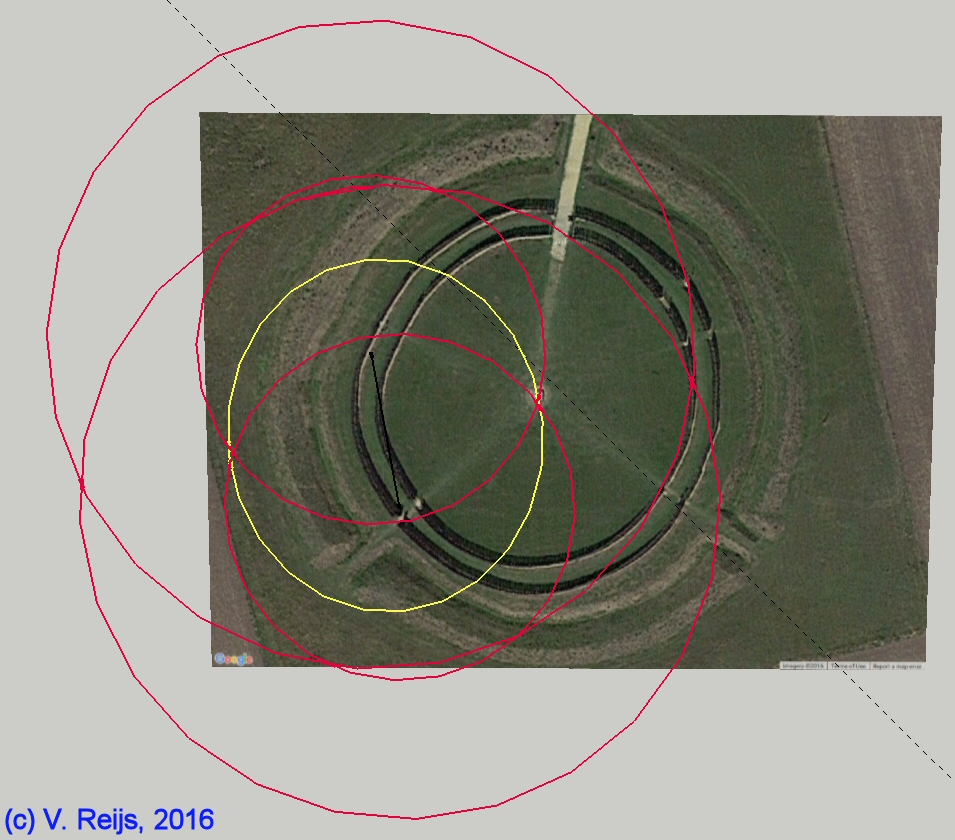
If the balloon is pop in a tangent direction (measured in May),
the reflections from the middle or far 1st palisade are
significantly reduced or non existent.
Chirp echoes were perceived at several microphone locations.
Word clarity
No word clarity test has been performed, as one could understand
each other in all areas within the 1st palisade (and
the background noise < 50dBSPL is much lower than
the speech).
Perceptions
- An interesting and possibly true statement is from Norma
Literski-Henkel (2016)
about Neolithic people:
Vermutlich waren sie zunächst selbst überrascht, welche
Effekte in der doppelten Palisadenkonstruktion entstehen.
- When clapping hands while coming closer to the 1st
palisade (1 to 2m) the sounds became more muffled/duller.
This could be the effect of decreased Preference,
which happens when reflections come from closer than 1.4m.
- Clapping hands, near the 1st and 2nd
palisade and as loud as possible, produced a chirp echo that was
well perceived.
- It looks that the large paper banger (flap is somewhat larger
than A3) is not able to survive (perhaps the strain/pressure is
just too large for ordinary paper at this size). The small paper
banger (flap based on A4) still works.
- It is important to keep the recording level as high as
possible. As a nearby pop can generate a high sound level, the
question is should one keep the same recording level for all
further away recordings. Perhaps better that one adjusts the
recording level in a controlled/deterministic way
- Two people were sitting and hand clapping
in the centre of Goseck, with their backs to the listener. Half
way between centre and 1st palisade, a shamanic
drummer was sitting. The listener was standing some 20m from the
drummer and hand clappers (and looking at the backs of the hand
clapping people on the right side). The direct sound of the hand
clapping was not really heard (attenuated enough), but the hand
clapping (its second image) came clearly from the left side.
A thought to use this effect: Two hand clapping people would be
back to back and one facing the listener. If they alternatively
would make (clapping) sounds, it would appear to switch between
left and right...
Press coverage
The Mitteldeutsche Zeitung, 'Das große Rauschen'
(9/5/2016) published an
article (with pictures) around the above acoustic research.
Others were also published: Mitteldeutsche Zeitung, 'Erbauer
von Goseck nutzten Klangeffekte' (11/5/2016); Magdeburger
Volkstimme, 'Forscher finden steinzeitliches Tonstudio'
(11/5/2016); ; Leipziger Volkszeitung, 'Goseck-Erbauer nutzten
Klangeffekte (11/5/2016); Dresdner Neueste Nachrichte,
'Goseck-Erbauer nutzten Klangeffekte' (11/5/2016); Bild Halle,
'Schall-Geheimnis in Goseck entdeckt' (12/5/2016);
and Altmark Zeitung, 'Goseck-Erbauer nutzten Klangeffecte'
(12/5/2016).
These news paper articles reached a readers' pool of around 1.25
million.
Further articles on the Internet: Die
Welt, 'Erbauer von Goseck nutzten Klangeffekte für
Rituale' (10/5/2016); Die
Welt, 'So ausgefeilt war die Klangtechnik der Steinzeit'
(10/5/2016); and FOCUS
Online, 'Erbauer von Goseck nutzten Klangeffekte für
Rituale' (10/5/2016).
Pömmelte-Zackmünde
Draw-away measurements
In this picture the draw-away
measurements at Pömmelte-Zackmünde are shown (they start with the
letter P and using Pink sound). No specific observation from these
measurements. We first had equipment problems and then there was
considerable wind (low force 4), so further measurements were not
possible.
Comb effect
Brown noise draw-away measurements were done from the centre of
Pömmelte-Zackmünd upto 7 steps away (1 step is approximately 1m).
In the below spectrogram one can see; that when walking from 7
seven steps towards the centre (0 step) and then again 7 steps
away, equally spaced bands of frequencies are attenuated and the
bands move up in frequency when going further away from the
centre. This is related to the comb effect: the interaction
between the direct sound and the reflection against the ground
plane.

Similar draw-away was done when using Shamanic drum (now up to 10
steps from centre). The sound changed considerable in timbre when
closer than 7 steps from the centre; more high pitches were heard
which can be seen to emerge in the spectrogram.

Chirp echoes and whispering gallery effects
Chirp echoes were very faint and no whispering gallery effects were
experienced. Possibly due to more rough positioning of the posts.
IRs from centre
In general we see reflections due to a ballon pop: from the near
palisade; one that has gone to the far side of the palisade (~0.22
sec = ~74m); and one that went between the near and far sides of
the palisade (~0.42 sec = ~149m).
Depending on the distance from the near palisade, the reflections
from the near palisade arrive faster after the direct sound;
reflections from the far palisade keep the same timing from the
direct sound (flutter echoes).
Most of the energy of the reflections are in the range between 150
and 400Hz, the later the less higher frequencies with every wave
(which ends with another reflection against the far palisade
reaching the observer). See below spectrogram.

A balloon pop has enough powerful frequencies between 150
and 2,000Hz, so the circle's acoustic properties have
changed the original spectrum of the balloon pop during each wave.
See also section Reflections in circle for
an evaluation of the results.
Word clarity
No word clarity test has been performed, as one could understand
each other in all areas within the 1st palisade (and
the background noise < 50 dBSPL is lower than the
speech).
Observations at Heldenberg (Sept.
2013)
There have been done acoustical measurements Heldenberg on Sept.
2nd, 2013 [Pomberger & Mühlhans, 2015].
Date
|
Location
|
Wind speed [km/h]
|
Wind direction
|
Beaufort
|
Temp [oC]
|
Air pressure
[mbar]
|
Sound
speed
[m/sec]
|
Humidity [%]
|
2/9/2013
|
Heldenberg |
~37
|
WSW |
high 5
|
~20
|
~1022
|
~343
|
~52
|
In the below paragraphs some of their findings are summaries, so
that they can be compared to our own measurements.
Source source
Balloon pop (~25cm diameter) positioned in the centre. And
pricked at the tip of the balloon (directed to the sky).
Source height at ~1.3m and receiver height at ~1.7m
Chirp echoes
One could detect a chirp echo when the observer is near the
palisade and the balloon pop at the centre. It is expected that
the chirp echo will be more pronounced with the balloon pop is
near the palisade.
IRs from centre
The setup used:
In the centre the IR shows a flutter echo with a periodicy of
~70ms, which is equivalent to the diameter of the circle. The
reasoning in the article is that the centre is a kind of focal
point (Brennpunkt), but perhaps better to call it a focus
point. The flutter echo is also pronounced in the centre as there
is a perpendicular (white path) direction of the terrain slope and
thus lowest loss for a flutter echo.
If the observation point is further from the centre, the perceived
flutter echo is reduced according [Pomberger & Mühlhans, 2015,
page 25]:
Auf halbem Radius des Kreises treffen die Echos jeweils
zeitversetzt im Abstand von etwa 35ms ein, wodurch der Impuls
in der Hörwahrnehming zu einem Schallereignis
verschmilzt [precedence], das Flatter echo ist dort
nur messtechnisch erfassbar.
The measurement was perpendicular to the terrain slope (white path),
and it looks the terrain slope has not introduced
additional losses.

Heldenberg IRs, balloon in centre and mic at 6m [IR from
Mühlhans, 2015]
They also did measurements of
tangent (purple path) to the terrain slope, when the mic was 6 and
12m from centre (near the palisade/entrance). In the 12m case, there
is no palisade but an entrance, so no near palisade
reflections/diffractions. Looking at the energy there does not seem
to be a significant different between the two directions for both 6
and 12m. The 12m ones sound slightly differently, perhaps due to
timbre or low preference effects the near palisade.
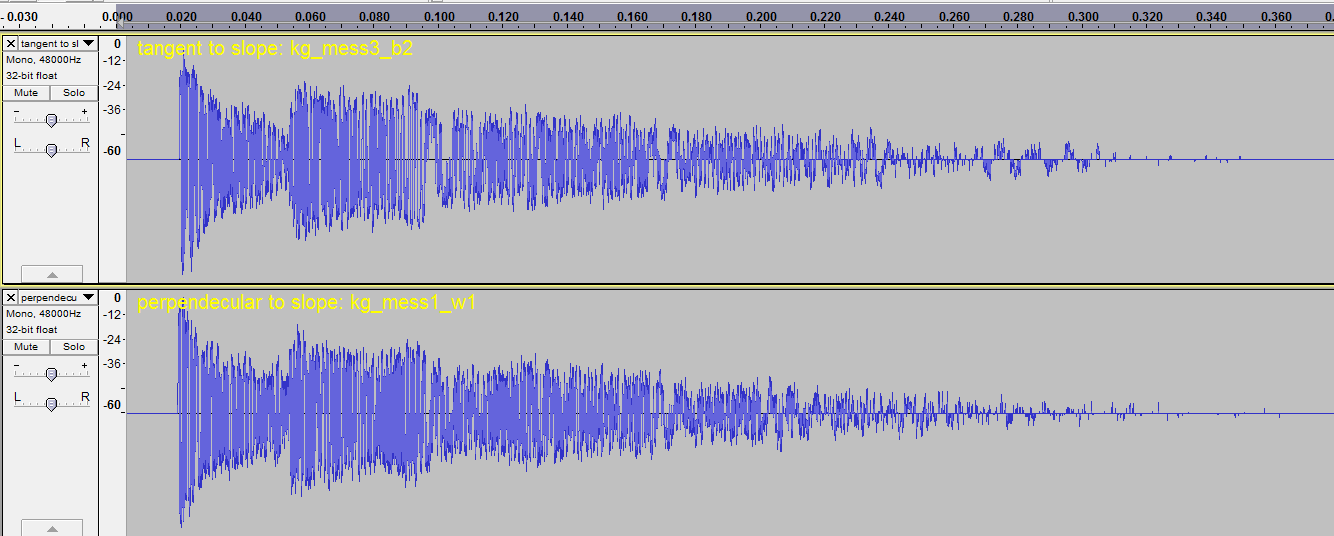 Heldenberg IRs, balloon in centre and mic at 6m: tangent and
perpendicular to terrain slope [IRs from Mühlhans, 2015]
Heldenberg IRs, balloon in centre and mic at 6m: tangent and
perpendicular to terrain slope [IRs from Mühlhans, 2015]
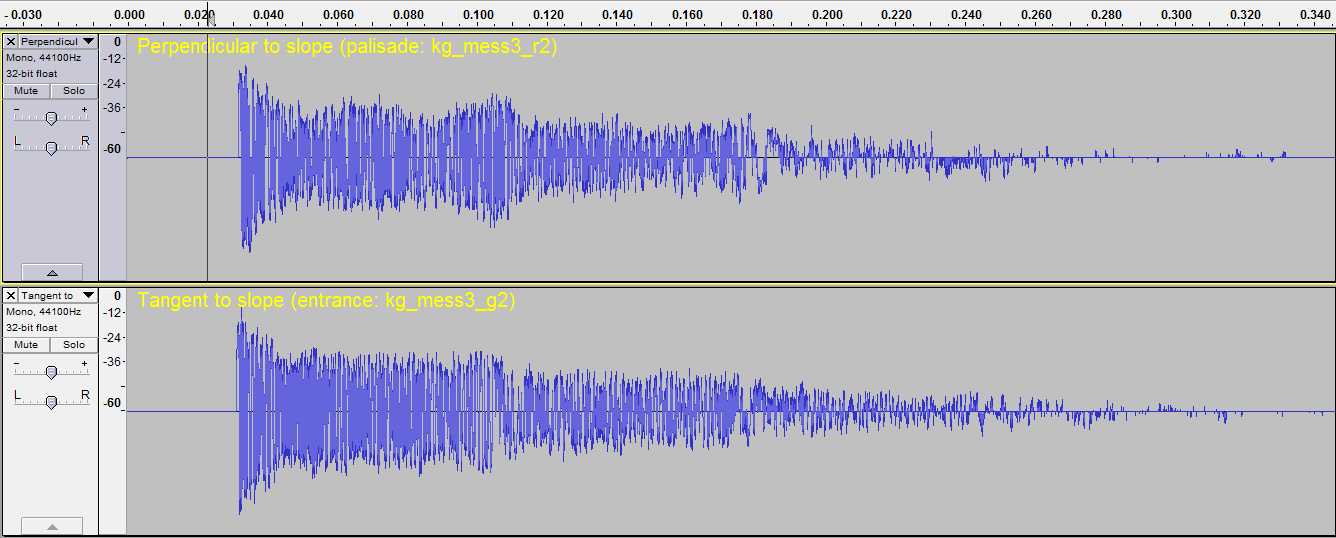 Heldenberg IRs, balloon in centre and mic at 12m: perpendicular
and tangent to terrain slope [IRs from Mühlhans, 2015]
Heldenberg IRs, balloon in centre and mic at 12m: perpendicular
and tangent to terrain slope [IRs from Mühlhans, 2015]
The T20 for the perpendicular (white) and the tangent (purple) path
are respectively: 0.43sec and 0.42sec.
Tightly-spaced double palisades as noise
barrier
The noise level difference between inside and outside the
tightly-spaced double palisades is around 12 dB. This is
considerable higher than at Goseck (a few dBs), which has no
tightly-spaced double palisades. But lower than behind the bank of
Grange Circle B (19 dB). See also this
section.
Lesson learnt
The following ideas and lessons learnt are perceived:
- prick the balloon at the top, to give a more balanced N-wave
response of the pop's impulse [Deihl, 1968].
- if a terrain slope; measure the IRs perpendicular and tangent
to the terrain slope.
- would be interesting to have a balloon pop near the palisade,
to hear if chirp echo occurs at Heldenberg.
Performance test at the Grange Circle
B (April 2017)
Participants
Victor Reijs, Noirin Ni Riain, Moley Ó Súilleabháin.
Date
|
Location
|
Wind speed [km/h]
|
Wind direction
|
Beaufort
|
Temp [oC]
|
Air pressure
[mbar]
|
Sound
speed
[m/sec]
|
Humidity [%]
|
25/4/2017
|
Grange |
~19
|
W
|
high 3
|
~8
|
1024
|
~336
|
~40
|
26/4/2017
|
Grange |
~3
|
N
|
1
|
~3
|
1025
|
~333
|
~93
|
Equipment
- Zoom H1 plus wind muffler and binaural microphones, microphone
boom
- 2*1W CD player
- CD with sounds (brown, pink noise, babble, Bronze Age Horn,
whispering, squealing pigs)
- claves, bodhran, flute
- vocal Hip-Hop sounds (by Moley Ó Súilleabháin)
- chanting by Noirin Ni Riain and Moley Ó Súilleabháin
Experience performance of different sound sources
- The vocal Hip-Hop sounds made by Moley Ó Súilleabháin
had great clarify and definition when walking from middle
towards the large stone Rannach Crom Dubh.
Observations at re-reconstructed Heldenberg
(June 2017)
Participants
Victor Reijs, Reinhard Mussik, Finn Hockauf and Elke Hockauf
Dates
There have been done acoustical measurements at the re-reconstructed Heldenberg on
June 2nd to June 4th, 2017.
Date
|
Location
|
Wind speed [km/h]
|
Wind direction
|
Beaufort
|
Temp [oC]
|
Air pressure
[mbar]
|
Sound
speed
[m/sec]
|
Humidity [%]
|
2/6/2017
|
Heldenberg |
~6
|
E |
low 2
|
~21
|
~986
|
~343
|
~60
|
| 3/6/2017 |
Heldenberg |
~5
|
W
|
1
|
~26
|
~983 |
~347
|
~52
|
| 4/6/2017 |
Heldenberg |
~16
|
S
|
3
|
~25
|
~976
|
~346
|
~65
|
In the below paragraphs some of the findings are summarised.
Sources
Balloon pops
Exponential Sine Sweep (ESS: 50 - 4000 Hz in 10 sec) using 2*8W
RMS loudspeaker (height ~1m above ground)
Zoom H1 plus wind muffler on microphone boom (height ~1.25m above
ground)
Influence on response due to terrain
slope of Heldenberg
The microphone was place on a boom in the centre of Heldenberg
(see below picture).

The loudspeaker was moved in intervals of ~2.2m from the centre
over three paths (see the open dots in above picture). The three
paths being:
- the white path, which has a terrain rise of some 0.9m over the
diameter of the circle (terrain slope ~2deg)
- the yellow path, which has a terrain rise of some 0.2m over
the diameter of the circle (terrain slope ~0.5deg)
- the red path, which is more or less using the steepest terrain
slope in the circle: a terrain rise of some 1.8m over the
diameter of the circle (terrain slope ~4.5deg)
A Sine Sweep (50 to 4000 Hz) was produced at each interval (at 0,
~2.2m, ~4.4m and ~6.6m from centre) and the resulting Impulse
Response (IR) was derived using Audacity with Aurora Plug-in. Two
times four IRs for each path can be seen at the top of below each
three rows in the below graph.
The three rows of graphs relate to:
- The top row provides the two times four IRs on the White path:
the Left side and on the Right side (referenced with ones back
to the lowest entrance)
- The middle row provides the two times four IRs on the Yellow
path: the Left side and on the Right side (referenced with ones
back to the lowest entrance)
- The bottom row provides the two times four IRs on the red
path: the UPper side (near the highest entrance) and on the DoWn
side (near the lowest entrance)
Each IR is presented as a frequency spectrum graph over the first
300msec: yellow, highest power; red, intermediate power; blue, low
power; and light grey, no power. A flutter echo of ~70msec can be
seen in the IR graphs.
Comparing the different paths (with different terrain slopes), there
is no real difference in the IRs, except that the W(hite)R(ight) IRs
seem to persist a little longer. The red path's UP and DW might be
slightly lower in power.
But overall the IRs look to have the same behavior in distance from
centre of the circle and in time.
This is not really expected as the height
of the palisade (1.9m) is just a little lower than the threshold
height (~1.95m) for Heldenberg's terrain slope. That the reflections
are still pronounced can be due to two things: a) the second row of
posts (~2.3m) has influence or b) the effective acoustical height is
larger than the actual height.
Producing clave sounds at different heights
The claves have been used at the UP and DoWn locations (on the red
path) and then at different heights from the ground level: ~1m,
~1.6m, ~1.75m and ~2m. The microphone is at a height of around 2m
At the UP location, a flutter echo is seen for most heights,
although when the claves are at 2,m height the flutter echo is
barely noticeable. Have not been able to explain this on a
theoretical level, as the microphone is for any clave height level
at a lower, so even the reflection from the opposite palisade (which
is some 1m lower again) is not really possible, let alone a flutter
echo! So scattering of sound must be happening within the circle.
For the claves at the DoWn location, beside the direct sound only
the echo of the far (UP) palisade is registered at the microphone.
After that no flutter echo. This is also following the theoretical
path of the sound due to reflections.
This behavior is not fully understood yet.
Comparing
Heldenberg of 2013 and 2017
A balloon burst has been used to compare the T20 properties
(remember that T20 is not really defined in a non diffusing
environment) in 2013 (distance 6m by Mühlhans)
and 2017 (distance ~4.4m by Reijs):
There is some difference seen between the two authors in the tangent
and perpendicular paths.
For the tangent paths (see above picture): T20 of Mühlhans' purple
path is around 0.42sec and of Reijs' red path is 0.46sec. A similar
difference is present for the perpendicular paths: Mühlhans' white
path is around 0.43sec and Reijs' yellow path is around
0.47sec.
The JDN for the T20 is around
4%, so the difference between the decay times measured by Mühlhans
and Reijs is perceptible.
The reason could be that Mühlhans' tangent measurements are from
entrance to entrance, while Reijs measured (slightly more anti-clock
wise) between the lowest and highest points which have palisade
behind them. Another reason for the difference seen in both
paths could be that Mühlhans measured 6m from the centre, while
Reijs measured ~4.4m from the centre.
The perpendicular path results are though also somewhat unexpected
as the 2017 palisade is less well spaced (4%) than
the 2013 palisade (<1%), see for instance on the right side
of below picture where the gaps are much larger:
Lessons implemented
The following ideas and lessons have been implemented:
- balloons were pricked at the top and the top directed towards
the recorder. This to give a more balanced N-wave response of
the pop's impulse [Deihl, 1968].
- the IRs perpendicular and tangent to the terrain slope have
been extensively measured (see above).
- balloon pops have been done near the palisade, no chirp echos
occurred at Heldenberg. Perhaps due to the smaller circle
diameter and/or the peeling bark.
Evaluation
Flutter echoes in a circle
If we have a circle and the impulse sound is in the centre, the
resulting peaks in the sound level change with the distance of the
observer from the centre:
- the direct sound arrives (define this at t=0 and a normalised
Sound level 70dB)
- then the 1st reflection, due to direct sound,
returning from the nearest palisade side
- then the 2nd reflection returning from the furthest
palisade side
- then the 3rd reflection, due to 2nd
reflection, returning from the nearest palisade side
- then the 4th reflection, due to 3rd
reflection, returning the furthest palisade side
- further reflections seem to be too low in power to come
normally above the noise.
In the below stylised and animated graph we see these peaks
changing while the observer distance is increased in a single
palisade ring. For comparison: A impulse sound at 27m from 1st
palisade with the observer at distance of 10m from impulse
response: the measured impulse response at 10m at Goseck has been
overlayed. This are clear examples of flutter echoes.
One sees more flutter echo peaks in the
Goseck impulse response due to the 2nd palisade
reflections (8m or 23msec later).
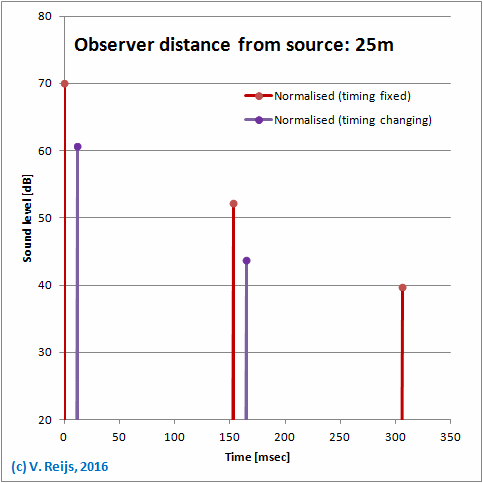 Goseck IR, balloon in centre and mic at a several distance
(diameter 52m)
Goseck IR, balloon in centre and mic at a several distance
(diameter 52m)
The direct sound (per definition at 0msec) and
the reflections (2
nd and 4
th) returning
from the furthest palisade side are fixed in time (independent
of the distance of the observer from the centre) [red lines].
The reflections (1
st and 3
rd) due to the
nearest palisade side change in time (dependent of the distance
of the observer from the centre) [purple lines].
The height of the lines depends on the total length of the sound
path (and the number of reflections against furthest or nearest
palisade).
When the reflections come into the 10 to 40msec range, timbre
changes can happen. Below10msec preference can be lowered (see
section on
Discrete reflections).
This also maps well on theoretical flutter echoes in Heldenberg
(mic at 6m):
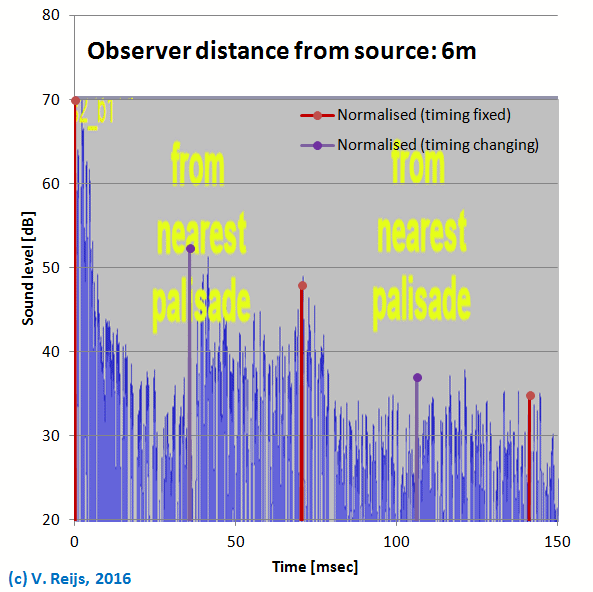 Heldenberg IR, balloon in centre and mic at 6m (diameter
24m) [IR from Mühlhans, 2015]
Heldenberg IR, balloon in centre and mic at 6m (diameter
24m) [IR from Mühlhans, 2015]
So it looks that Goseck and Heldenberg (in tangent direction of
terrain slope) behave similarly (even the loss due to a
reflection against a palisade, is in both cases ~8dB).
A flutter echo can give an impression of a larger room then one
expects, see
this
perception when flutter echo happens in a room. This is
perhaps also the reason why in open air moment one gets the
impression of a larger enclosed space when a flutter echoes
happens.
Transparency of the palisades
The palisades of the circles have different area of gaps between
the timber posts. Below are pictures of front view (and almost the
full height of posts is included) of the 1st palisades.
Site
[picture taker]
|
Palisade picture
|
Straightness
&bark
|
Terrain
slope
(deg)
|
Gap area [%]
|
Goseck
[Reijs, 2016]
|
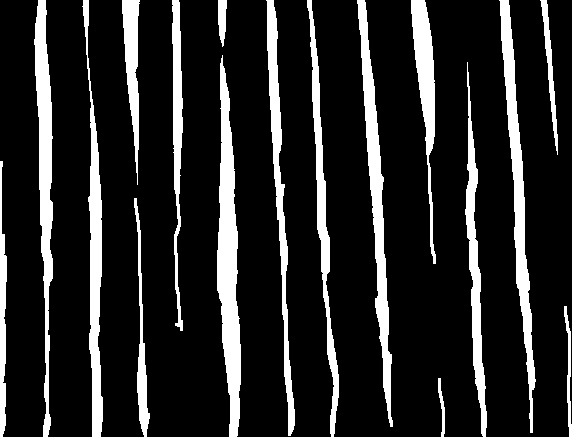
|
straight &
no bark
|
~0
|
16
|
Pömmelte-Zackmünde
[Reijs, 2016]
|
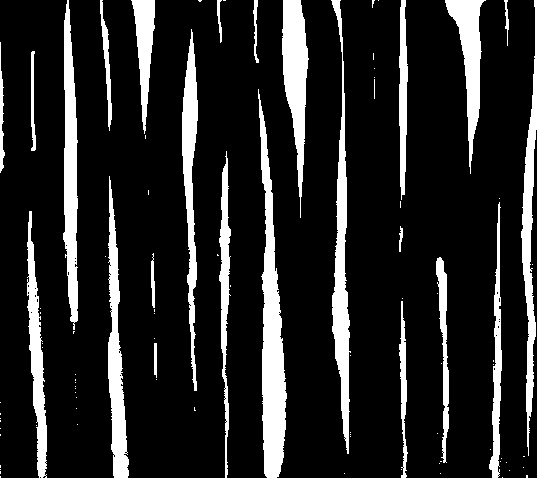
|
straight-ish &
no bark
|
~0
|
15
|
Mansfeld
[Meinike, 2005]
|
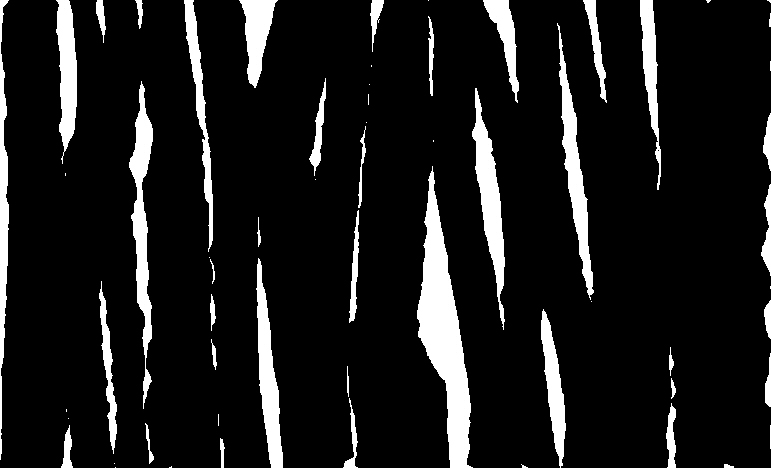
|
crooked &
many
(peeling)
bark
|
~2.5
|
11
|
Quenstedt
(original of Mansfeld)
|
NA
|
NA
|
~0
|
NA
|
Heldenberg 2013
[J. Mühlhans, 2015]
|

|
straight &
mainly bark
|
~4.5
|
~1
(as seen
from centre)
|
Heldenberg 2017
[Reijs, 2017]
|

|
straight &
mainly bark |
~4.5
|
4
|
Schletz
(original of Heldenberg)
|
NA
|
NA
|
~6
|
NA
|
The reflection energy of these palisades does not differ that
much (max difference 0.4 dB for middle [(353 - 1414Hz] and low [88
- 353Hz] frequencies [Ahnert, page 37], which would not really be
audible, as it is below the JND of 1dB).
Diffraction might be different due to large variation of
straightness of the posts.
Transparency of the palisades also will have an influence on the
transmission of sound behind the palisade, the more dense the less
energy.
Perceptions and stories
- Goseck:
- From a visitor to Goseck [Reinhard,
pers. comm. 2016]:
When we were first in Goseck we could not recognise any
sound effect. The cause was that we did not know that
there could be a special sound. Only after the guided
tour we could recognise these effects.
The
spatial impressions were still noticeable when there
were some 100 people within the Goseck circle during the
winter solstice festivities.
- From an
anonymous visitor during a windy day (anonymous, pers. comm.
2017):
When I was in Goseck the last time it was very windy
and the special acoustics, that many people told me about,
was untraceable.
Inside of Pömmelte-Zackmünde [Reijs, 2016]
- Acoustical experiences [Meinike,
pers. comm. 2016] at the reconstructed Quenstedt at Mansfeld, indicates that
there were no acoustical effects perceived. She thinks this is
possibly due to the sloping terrain, the gaps and/or the bark.
 1st palisade at Mansfeld (photo by M. Meinike, May 3rd, 2005)
1st palisade at Mansfeld (photo by M. Meinike, May 3rd, 2005)
- the terrain might be somewhat sloping (~2.5 deg: according
tot Google Earth: 2m height difference within 1st palisade
ring). It might be that this is the reason
for a reduction of echoes, but still not sure.
- the Mansfeld posts are more crooked than Goseck (more
diffraction towards different planes);
- many posts in Mansfeld still have (peeling) bark (more
absorption, more scattering, more diffraction; although
Heldenberg has posts with [non peeling] bark and a very good
echo);
- the gaps between Mansfeld posts are somewhat smaller (the
reflection though should not that different);
- the wind condition at Mansfeld could be different (not
really as on May 3rd, 2005 wind was low force 3). Wind
can have an effect when it is more than 5m/sec (high
force 3) and when distance between source and observer is much
more than 30m [Albert, 2004, page 7];
- something else?
A video with sound made at the former site might help
also, if available please inform us.
- Heldenberg has the posts in such a way that a
gap is covered by another post (slightly more inside): tightly-spaced double palisades, when looking
sideways one though can see the gaps [Pomberger, 2015, page 23]. Heldenberg is on a
terrain slope of around 4.5 deg.

Posts
placement at Heldenberg (J. Mühlhans)
-
The Echo in the
centre is really amazing!, according to
Zotti [pers. comm. 2016].
- Goats roaming around the area of
Heldenberg would pass a lot of time inside the timber circle
(Aigner, 2017).
- The first time walking into Heldenberg, did not give me
the same feel (sacred) or spatial impression as with Goseck
or Pömmelte-Zackmünde. The reflections/echos
were less obvious (Reijs, 2017).
- Goseck is isolated in the landscape and you have to go a
long "processional way". All this gives a more sacred
character to Goseck than Heldenberg. When we first entered
the Goseck circle (we were alone), we just had a "scary"
feeling and left it quickly. Maybe, the fact that Goseck was
rebuilt on its original place (a place which was discovered
or chosen as a sacred place for some reason millennia ago)
was one important cause for this feeling? The
considerable terrain slope at Heldenberg detracts the
impression of being in a closed space. Furthermore the
sloppy built palisade, the short - only indicative - ditch
and wall, and the integration into a "theme park" (Neolithic
village, falconry, museum ...) gave more the feeling of
being in a playground than in a sacred enclosure.
(Mussik&Hockauf, 2017)
Influence of a terrain slope
In case we look at horizontal wave fronts when there is a terrain
slope, sound energy can be lost depending on: the diameter of the
timber circle; height of the palisade; the terrain slope; height of
the source, and height of receiver. The threshold terrain slope not
to loose energy is depending on the height of the source, as can
be seen in the below picture (timber circle diameter 52m, palisade
height 2.5m, source in centre, receiver at same absolute height as
the source).
If the timber circle is smaller (like Heldenberg: 24m) the threshold
terrain slope not to lose energy is around 7deg. Heldenberg
(2013 situation) is on a terrain slope of around 4.5deg, so that is
why there is low loss perceived.
Furthermore, when having a sound source perpendicular to the terrain
slope, the losses will also low; as the palisade sides are at the
same height (like there is no terrain slope;-). So the IR
perpendicular to a terrain slope would be very similar to the IR of
a site on flat terrain.
It is interesting to see that
Austrian timber circle entrance pairs have a tendency to be more or
less tangent or more or less perpendicular to the terrain slope
[Zotti, 2011; ASTROSIM]. This is
indeed quite evident for the Austrian KGAs, see below:
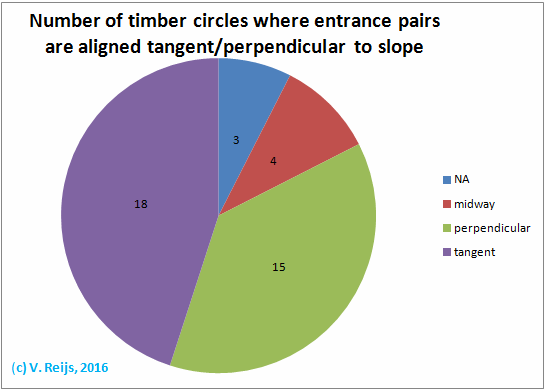
Would this have a relation with the acoustic
aspects of tangent and perpendicular to the terrain slope? And
would the same yield for German circles (which are from a
different region/culture)? No real answer available(yet), but
there might be a thesis in 2017/2018 that could provide the
basic data for this evaluation (Michel, possibly 2017).
An initial comparison (based on tentative data gotten from
Michel on position of the German circles) between the cumulative
distributions of the terrain slope seen (dashed line) in
Austrian and German circle can be see below (the continuous line
would happen if both cumulative distributions would be the
same):
There might indeed be a difference in terrain slope distribution
(although it still needs to be investigated if the general
distribution of terrain slope for the larger region in Austrian
and German are different). It looks that more German circles
than Austrian circle are build on flat terrain. The spread of
the terrain slope is for both regions similar (maximum 7.5 deg).
Looking at the 32 timber circles in Austria (KGA: Keisgrabenanlage)
[pers. comm. Georg Zotti, 2015; ASTROSIM], it has
been determined how many circles would have large losses for sounds
tangent to the terrain slope (assuming palisade height 2.5m and
source height 1.25m). 19 would have large losses, while13 timber
circle would have low losses; this looks to be a random behavior (χ2-test;
p=0.05). And also the relation between entrances direction, terrain
slope and timber circle diameter looks to be random.
Noise barriers
Noise barriers cause the receiver to experience a shadow effect,
and sound reaches the receiver through diffraction.
There are two types of noise barriers that can be present at
timber circles:
Timber palisades will only be effective sound barriers if the gap
area is below the 2% (if more then 10% one can't perceive the
difference) [BC Ministry of Transportation and Highways, 1997, page
2]. The investigated timber circles (except Heldenberg) all have a gap area of more than 11%. The tightly spaced
palisades (like the tightly-spaced double palisades of Heldenberg)
and banks (like at Grange Circle B) are more effective noise
barriers.
The attenuation due to the barrier (compared to the situation with
no barrier) is depending on the path length difference with and
without barrier. If the source or observer is closer to the barrier,
the larger the path length difference is. Other background
information (and worksheets) can be found in [US Department of
Housing & Urban Development, 2009, page 9-13, 23-25].
The attenuation looks something like below graph [BC Ministry of
Transportation and Highways, 1997, page 2]:
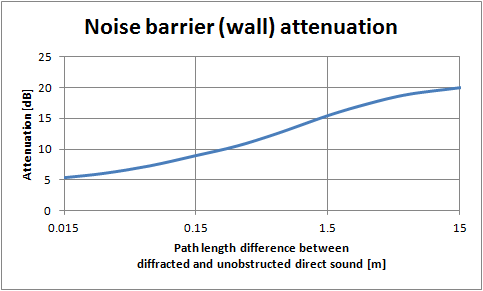 For illustration purposes only
For illustration purposes only
Here is a handy
2D interactive tool and a
1D
from tool: source at 0m, barrier at 12m and receiver at
15m (more or less Heldenberg). One can derive at Heldenberg that
the sound level before the barrier and after the barrier has a
difference of around 15 dB (
measured is 12
dB). For Grange Circle B, with its 9m wide bank (and stone
circle at 1.5m)
the
tool gives around 10 dB, while measured is
was around 19 dB.
The above information is for a noise barrier wall (a tightly
spaced palisade), a bank's attenuation would be a few dB lower
[BC Ministry of Transportation and Highways, 1997, page S-1,
S-2].
Draw away measurements (loudness)
Equipment
An SPL meter was used at A-Weighting and Slow response.
The SPL meter was held at around 1m height and against the body of
the measurer. The microphone directed to the speaker. The speakers
were at around 75cm high. Everywhere the ground was covered with
(mowed) grass, although at Pömmelte there was some wild plant
growth (upto some 30cm).
Measurements
Naming convention of the measurements:
- First letter is the location: Home garden (H), Goseck (G),
Pömmelte (P) and Field (F).
- Next two (if present) long what axis has been measured: Long
Axis (LA) or Short Axis (SA) of the circle
- Next letter (if present) shows if walking towards Palisade (P)
or Entrance (E)
- In most instances Pink noise was used, but sometimes Brown
noise, Whisper or (Bronze Age) Horn.
- The distance in the below graph is measured from the centre of
Goseck and Pömmelte or a reference point in the Home garden and
Field.
- All graphs were normalised to the same dBSPL at 10m
(70.5dBSPL).
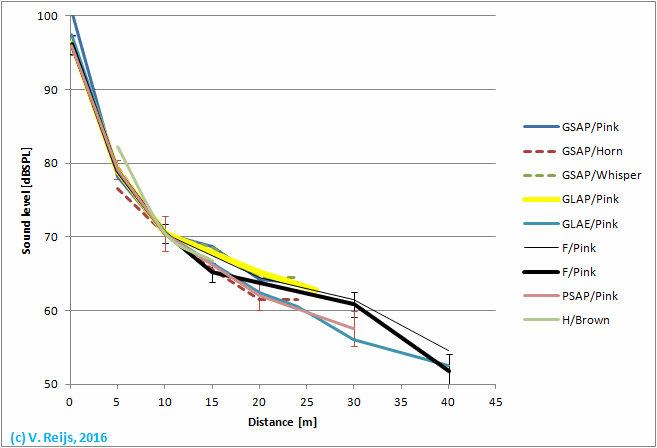
The differences between the draw-away curves are not that large.
The following evaluations can be made:
- The background noise was smaller than 50dBSPL.
- All graphs are quite close to each other (except in case there
was influence due to wind). There is a small difference between
the (normalised) sound pressure levels measured with different
sound sources, but all this might be within the standard
deviation.
- Reproducibility of a measurement was around 1.5dB (1 sigma)
- The wind and/or speed direction fluctuations (irregular
amplitude fluctuations: IAF [Brown, 2003, page 121]) caused
fluctuations in the measured power (up to plus/minus 4 B [say 2
sigma]).
- The errors for F/Pink and PSAP/Pink (depicted as vertical
error bars) are due to reproducibility and wind
noise&direction fluctuations (each might have comparable
influence).
- The observed average standard deviation between all
measurement at a certain distance was 1.5 B (1 sigma).
- The average level (using a SPL meter of Radioshack) change
looks to be around -6.7dB/dd (doubled
distance), this is more than in a hemispherical environment,
where it is around -4 to -5 dB/dd or free space -6dB/dd
[Everest, 2001, page 88]. These level changes are for omni
directional point source, a loudspeaker is directional and not
point like. In open space: a speaker's near field (smaller than
1m) would change with -12dB/dd and the far field (larger than
1m) would be -6dB/dd [Crocker, 1998, page 8]. So this does not
explain the sound level change of around -5.5 to -8dB/dd in open
field compared to the hemispherical environment of -4 to
-5dB/dd.
Lessens leanrt
- Use C-Weighting in the future (is closer to relative loudness
perception) [Toole, 2013, page 346-348]
Reverberation time
In most cases, with the sound source in the centre and the mic at
10m from the centre: the reverberation time (T30; derived through
the Open
AIR web page [Murphy]) and ¿Volume? (defined by the height
of the palisade/stones, by assuming the circle is closed with a
[absorbent] plane) of the circles were derived:
- Pömmelte-Zackmünde (10m in circle): T30=0.70sec,
¿Volume?=9500m3
- Goseck (10m in circle): T30=0.57sec, ¿Volume?=4400m3
- Grange Circle B (10m to Dubh): T30=0.46sec, ¿Volume?=2400m3
- Heldenberg (2.2m to centre): T20=0.41sec, ¿Volume?=950m3
- Dromagorteen stone circle (10m to portal): T30=0.3sec,
¿Volume?=65m3
An overview of the optimum reverberation time (T60)
depending on the Volume can be seen in the below graph:
 The
optimum reverberation time [Chan; fesi, 2007, page 57;
Everest, page 154; line graphs: Reijs, 2016]
The
optimum reverberation time [Chan; fesi, 2007, page 57;
Everest, page 154; line graphs: Reijs, 2016]
The line graphs are based on [Stephens, 1950]:
K = T
60/( 0.0118*Volume
1/3 + 0.1070)
with: Volume in m
3
T
60
= optimum 60dB reverberation time [sec] at 500 Hz
K =
(optimum) suitability: 4 for speech, 5 for orchestra, 6 for
chorus
It is important to realise that the T30's (estimator of RT
60)
relation with ¿Volume? might not be really applicable for this
type of open air monuments, which does not really have a real
Volume (see also [Pomberger & Mühlhans, 2015, page 25]):
- A relation between the (optimum) reverberation time and
Volume is only defined in spaces where there is a
diffused sound field, which is certainly not the case for
these open space measurements.
- The ¿Volume? is based on the assumption that it is a
closed space, while the 'ceiling' of the space is fully
open.
- Reverberation randomises time [Blesser, 2007, page
246-247]. In the case of the timbre/stone circles there is
almost no reverberation due to a random reflection process.
There is some, but most energy is due to discrete
flutter echoes.
If the above optimum reverberation time-¿Volume? relation
is though relevant in some way; studio (speech); cinemas;
television studios; openplan offices; and pop and rock concerts
are 'applicable' for the measured T30.
But there were forests in the past and these can have
reverberation times between 1sec and 2sec [Shelly, 2013;
Grzinich, 2015], so larger then perceived in timber circles (T30
of up to 0.7sec). Is the timber circle a symbolic version of the
forest, to replicate the natural reflections and/or supernatural
voices?
Also interesting that Spengler says that 'The character of the
Faustian cathedrals is that of a forest' and that the 'Cathedral
and organ form a symbolic unity like temple and statue'. Of
course organs meld very with a cathedral due to the long
reverberation times: 'the organ, which roars deep and high
through our churches in tones that, [...] seem to know neither
limit nor restraint' [Spengler, page 199-200; Schafer, 1977,
page 23].
But caution is warranted in interpreting the optimum
reverberation time! Clarity
might be a much better measure for open air monuments.
Early Decay Time
It is interesting to note that not T30, but the EDT (Early Decay
Time of the first 10 dB) is better related to the perceived
reverberance [Bradley, 2011, page 714]. The EDT for the
timbre/stone circles is broadly around 0.15sec, while the T30 is
broadly around 0.6sec. An EDT shorter than the T30 would
indicate an improved speech and music clarity [Brown, 2010]. The
EDT of Grange Circle B is higher (0.5sec) due to the large
reflection from
Rannach Crom Dubh, here the C
50
is indeed low (-3dB). Clarity can of course also be measured
with
C50 and C80.
Thus the reverberations times (T30~0.6sec) are close to a
present day living rooms [Evert, 2001, Figure 7-17], while the
EDT (~0.15sec) is close to a semi-anechoic space. Are
timber circle perceive as larger enclosed space, because there
is a disconnect between the perceived visible size of the open
space circle [Bregman, 1994, page 307,312] and the perceived
reverberation (the EDT or T30) of a dead room? Could this be
similar to the Moon illusion effect [Ross, 2002]?
Are the multiple flutter echoes generating envelopment and thus
causing this large spacial impression?
C50 and C80
In most cases, with the sound source in the centre and the mic at
10m from the centre: the C50 [weighted over 500, 1000,
2000 and 4000 Hz] and C80 [averaged over 500, 1000 and
2000 Hz] are derived through the Open
AIR web page. Here they are for the circles:
- Pömmelte-Zackmünde (10m in circle): C50: 19.4dB, C80:
19.1dB
- Goseck (10m in circle): C50: 10.9dB, C80:
9.3dB
- Grange Circle B (10m to Dubh): C50: -3.1dB, C80:
13.0dB
- Dromagorteen stone circle (10m to portal): C50:
26.7dB, C80: 29.4dB
Below gives an
overview of the calculated values for C50 and C80
[Marshall, 1996, page 375; Smaart, 2015, page 24-25]:

That the measurement of 10m from centre towards
Grange
Rannach Crom Dubh stone has a rating of Poor for C
50
(speech clarity), is obvious due to the fact that the 1
st
reflection has more sound power than the direct sound. All other
measurements show that indeed speech is well treated by the
monuments, as was also perceived by visitors at
Goseck and
Pömmelte-Zackmünde.
It seems all measurements show a high C
80 (music
clarity), aka good for electronic instruments. Perhaps percussion
instruments, with their well defined beats, also fit into that
category.
Discrete reflections
The reflections can perhaps be evaluated using below graph that
looks at a single reflection that has a certain delay after the
first (in)direct sound (the provided lines are based on Figure
6.6, 6.14 and 6.15 of Toole, which relates to an anechoic space).
The measurements at Goseck and Pömmelte-Zackmünde are of course
not in an anechoic space, but in an semi-anechoic space, but it is
expected that the behavior is not that far off. Furthermore the
comparison is using castanet sounds, as Toole does not have other
sound sources closer to Balloons (he investigated: clicks without
any reverberation, Mozart music and speech).

If there is a question mark before a label in the legend of the
above picture, the line has been derived by the web-author through
analogy of other acoustic. If the first reflection is above the
dotted line, that reflection would be perceived as a second image
by the listener (e.g. the red squares). If the first reflection is
between the dashed and dotted line, then the location of the
direct sound will be spread (ASW; e.g. yellow squares with red X).
Between continuous line and dashed line Precedence (Haas effect)
occurs for the direct sound location (e.g. yellow squares with
blue *). And if the first reflection is below the continuous line,
the reflection is not detected. Low Preference happens when the
first reflections is earlier than ~0.01sec, while for first
reflections between ~0.01 and ~0.04sec timbre changes (comb
effect) can occur.
If more than one reflection happens after the direct sound, it
looks that the latest reflection determines if one experiences a
second image.
For instance in Shamanic drum recordings, the experiences anywhere
in the circle is of a second image, because the reflection against
the far side of 1st palisade at Pömmelte-Zackmünde is
always ~0.22 sec after the direct sound (blue diamonds). If one
removes the reflection due to this far side 1st
palisade reflection, the remaining reflection (e.g. some of the
red diamonds in above picture) determines more or less if there is
a second (third?) image or not.
For music (red dotted line) any reflection would not really
provide a second image. For speech (green dotted line), these
remaining reflections would perhaps provide some second
imagine might when one is near the sound source, but in that case
the second image sound level might be quite small compared to
direct sound.
This can be seen also in the
below picture, where one can see from 0.08sec the extrapolated
echo (dotted) lines for different sound types (somewhat
following the theory of section 'Large spaces' of Everest, 2001,
page 359). The diamond symbols are the reflection sound levels as
measured from Shamanic drum sounds in Pömmelte-Zackmünde, while
the delay is related to the receiver distance from the 1st
palisade.
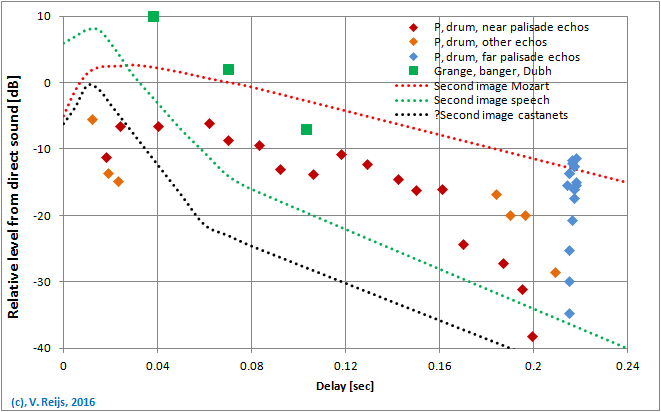
So percussion instruments (diamond symbols well above black
dotted line) have an advantage in Goseck and
Pömmelte-Zackmünde. This can be linked perhaps to the following
quote of HaYa RomanowSky on Goseck:
Wonderfull place in the world, my best place for drumming
and shamanic circle for freedom and peace with hayayoga.
Simulating a timber circle on sloping
terrain
To determine the effect of sloping terrain, a model of a timber
circle has been build in SketchUp Make (radius ~52m,
sound source 1m meter from centre and observer 10m from sound
source). Here is a picture of such a timber circle on slopping
terrain:
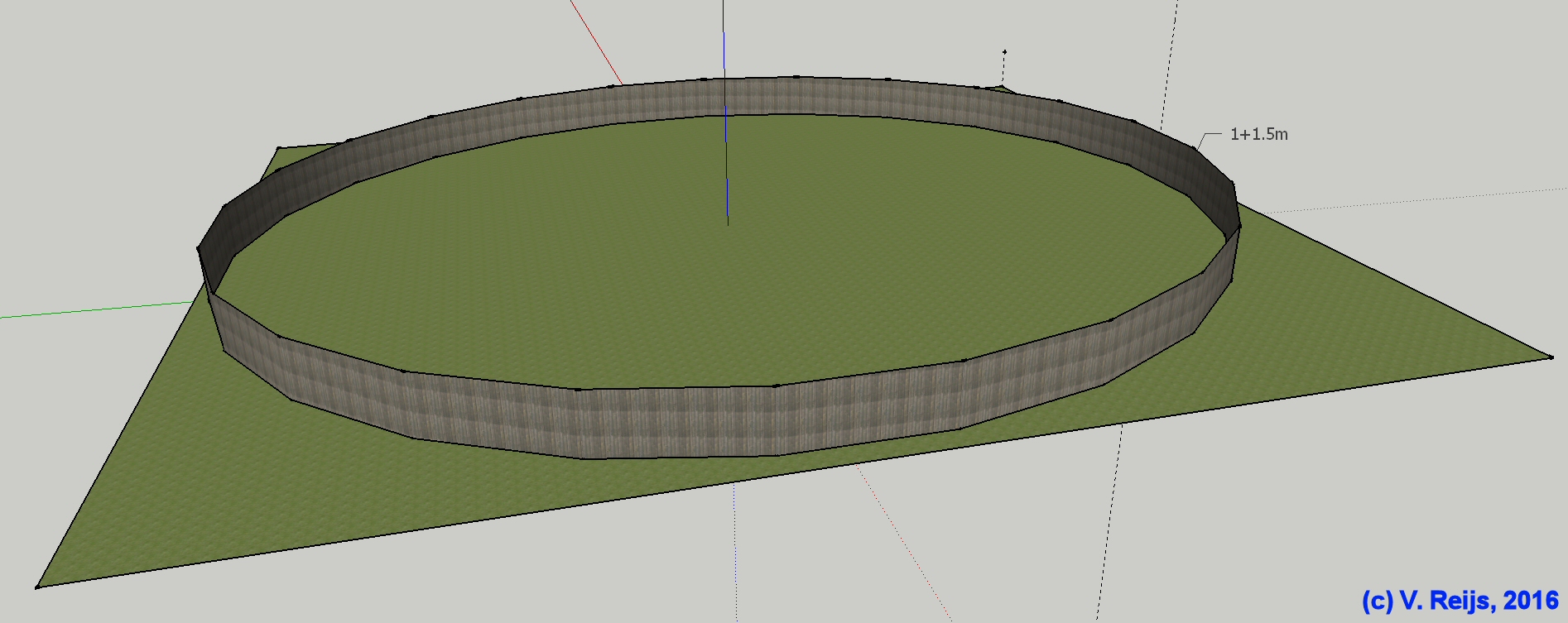
An Excel spreadsheet has been made to automate the parametrised
generation of a model of a timber circle looking at: circle
diameter, terrain slope, palisade height, gap between posts,
individual straight or randomly 'crooked' palisade posts. This can
be used to make a 3D model or an acoustic simulation of the site.
Several models have been made:
Type of circle
|
Terrain
slope
[deg]
|
Gap
area
[%]
|
Acoustic Absorption
Coefficient compared
to hardwood
|
Roughness
(peak-amplitude)
[m]
|
Closed circle
|
0
|
0
|
0
|
0.05
|
| Closed circle |
4
|
0
|
0
|
0.05
|
Straight posts
|
0
|
16
|
-16%
|
0.01
|
| Straight posts |
4
|
16
|
-16% |
0.01
|
Randomly 'crooked' posts
|
0
|
16
|
-16% |
0.007
|
| Randomly 'crooked' posts |
1.5
|
16
|
-16%
|
0.007
|
| Randomly 'crooked' posts |
4
|
16
|
-16% |
0.007
|
Auralisations of the closed circle models in the licensed
CATT-Acoustic v9.1 shows that the expected behavior with regard to
the reflections/flutter echoes can recreated: in case of a terrain
slope of 4deg much fewer flutter echoes are present in the
simulation.
Hopefully in the future a grant will be available, so more thorough
analysis can be done using acoustic simulation software.
<the demo version of CATT-A does not provide enough rays/cones to
achieve good results>
Auralisation
Some auralisations have been made of a drum
sound (recorded in anechoic room; available on Open AIR
library [Murphy]), which has been convolved (using Aurora
Plug-in for Audacity 2.0.0) with the IRs derived from our
measurements:
<below auralisations are somewhat harsh [used too short IRs and
sometimes there was even overload of mic]; new auralisations will
be included soon>
- Pömmelte-Zackmünde
- Goseck
- Grange Circle B
- Dromagorteen stone circle
- Heldenberg
Some of above auralisations (and IRs for different locations inside
a site) are available at Open
AIR library.
Summary
Some aspects to be reconsidered in the future for future acoustic
measurements at timber/stone circles:
- shadowing is experienced, when walking between the palisades
and openings.
Pink noise source in middle, observer between palisades.
Only investigated in Goseck.
- In Grange Circle B we saw a difference inside and outside the
circle of some 19dB. A similar effect might have happen if
Goseck had a bank of some 3m (according to archaeology).
Heldenberg's tightly-spaced double palisades also has an
attenuation of some 12dB. So attenuation would be quite high
indeed as described in noise
barrier section.
- chirp echo at 1st and at 2nd palisades
at Goseck.
Impulse source and observer at same place near the palisade
(although it is also heard when observer is further away).
Not at Pömmelte-Zackmünde and Heldenberg: due to more irregular
positioning of the posts. And not at Grange Circle B: too
irregular standing stone positioning. Not investigated at
Dromagorteen.
- Preference effect (reflections smaller than 2m from palisade),
only experienced when making sound at observer location.
Hand clapping was used.
Only investigated in Goseck.
- discrete reflections due to 1st palisade, both at
Goseck and Pömmelte-Zackmünde. Similarly at Dromagorteen and
Grange Circle B (due to standing stones). This provides apparent
source widening (ASW) and envelopment (LEV).
Impulse sounds (balloons) were used to record this.
- discrete reflections due to the two palisades at Goseck. This
is unique to Goseck and makes Goseck acoustically richer than
Pömmelte-Zackmünde. This provides additional apparent source
widening (ASW) and envelopment (LEV).
Impulse sounds (balloons) were used to record this.
- experience of being in a confined space (due to reflections)
instead of open field; even though that the draw-off
measurements are comparable.
Mainly pink noise was used to record this.
In all investigated sites, but not really present at
Dromagorteen (too small?).
- no whispering gallery effects in all investigated sites (used
humans whispering who could not hear each other when standing
opposite sides of 1st palisades).
- Vocal Hip-Hop sounds had a high clarity in the circle and
specifically at the large stone Rannach Crom Dubh, this
was not really experienced in Heldenberg.
- It is possible that the posts in former times were: different
heights; more crooked; more gaps; and/or remaining/peeling bark;
thus chancing the reflection and increasing diffraction and
scattering to different directions
- The flutter echos can be observed when using percussion
instruments, but not when using orchestra or choral sounds. This
maps on the perception seen by [Pomberger & Mühlhans, 2015,
page 26].
- A flutter echo can give an impression of a larger room then
one expects, see this
perception when flutter echo happens in a room. This is
perhaps is also the reason why in open air moment one gets the
impression of a larger enclosed space when a flutter echoes
happens. Neolithic humans have no experience of large closed
sites, but they still could have experienced the timber circle
as a difference place due to its acoustics (and not only because
it gives a visual boundary).
- The experience one gets in a timber circle is mainly due to
the reflections (and echos) within a certain time frame (nearer
than 40ms and longer than that). They give your the idea of
envelopment and source width. One could explain the experience
difference due to the resulting from flutter echos (between the
two palisade sides) and other echos/reflections.
Lessons learned
- synchronise the clocks and watches on all devices
- note properly where the (binaural) microphone(s) is pointing
to
- put phones in flight mode or off
- check if recorder is recording
- use wind muffler or cotton wool
- record impulse responses when wind
is lowest and when the bird don't sing yet (before sunrise).
Interesting to learn that birds sing in the morning (dawn
chorus) due to consistency of the acoustic properties [Brown,
2003]:
The average quality of dawn transmissions was not
significantly greater than those of midday, in either
habitat. Rather, the clear advantage gained by transmitting
signals at dawn was a reduction in the variability in
transmission quality.
- make sure there is 2 to 5 seconds of silence after the IR (the
longer the RT60, the more is needed).
- walk around and listen for: (chirp/flutter) echoes;
reflections, timbre-, pressure-, loudness- and/or
feeling-changes. Record the spot, time, what experienced, etc.
Speculative workflow how aural aspects emerge in buildings
Blesser provides a workflow how architecture could have been
developed in which acoustic/aural aspects played a role:
- Social needs determines size of audience
- Building technology limits size & geometry
- Size, materials, & shape determine acoustics
- Once constructed, listeners adapt to space
- Experience enhances subjective quality
- Future spaces replicate earlier spaces
- Incremental evolution by trial and error [Blesser, 2011,
slide 23]
How to determine if there is intend in former construction, can only
be done by using triangulation;
through investigating multiple sources, options or plausible
explanations. This maps very well on the methodology which Schaefer
[2004] proposed; a slightly
amended version is here.
Opportunities for the future
How could the circles be used in the past and how could they be used
for present day musical performances? Both parts of this question
could help with regard to understanding the aural interests of
modern and past people.
According to Trochimcyk (2001, 42), the circle has a semiotic and
symbolic association in music. Several compositions have been made
in the last century around a circular setup of the musicians and
audience. The circle provides a focus (its centre) and a
hierarchical ordering (inside and outside the palisade/bank).
Trochimcyk (2001, 45) thinks that composer Karlheinz Stockhausen
related his composition Carré to megalithic
circles and/or medicine wheels. Another music piece is based on the
circlar setup of Stonehenge: Trombonehenge by Charles Hoag.
While Iannis Xenakis created the composition Terretektorh, where
the audience and musicians inter mingle within a circular setup
(Trochimczyk 2001, 47-8). One should also look at the
tradition performances at the heart of the African village,
where audience and musicians are dynamic dispersed and moving around
this central area.
So could a Neolithic circle be used to make (modern) performances,
by utilising the circle‘s specific acoustic properties?
Percussion and speech (or music with a similar rhythm) look to
be mostly effected by the observed reflections and (flutter) echoes.
HaYa RomanowSky (2015) finds Goseck the best place for drumming. And
Noirín Ní Riain had an excursion with her student to the Grange
Circle B to determine where traditional folk songs and ancient hymns
could be performed best (Cassidy/Dormer/u. a. 2016, 120). She
further comments that the construction of such ancient sites and
genius loci (spirit of lace) was directly influenced by acoustic
considerations; the prime purpose of these communal sites was to
allow people to communicate through sound. And certainly, the
energies in the Grange Circle B alter radically in response to
sounds, particularly vocal sounds (Riain 2011). Another
investigation was by Beate Pomberger who performed with her
colleagues different Neolithic instruments at Heldenberg (Let/Luksan
2014; Pomberger/Mühlhans 2015).
So there are opportunities to determine how to use the specific
acoustic properties and to include them in present day aural
experiences. This by utilising: (flutter) echoes, clarity, timbre,
spatial impression and other acoustical measures. Furthermore
different/varying locations of the instruments, performers and
audience need to be explored; to determine how an Apollonian or
Dionysian type of performance (Schafer, 1977, 5-6) could yield
interesting results in present times. And this might give insight in
the aural/cultural background of the past.
So lets take Grange Circle B and
listen to several auralised sounds:
*this row will be replaced with an anechoic recording.
The yellow highlighted sounds are significantly different from the
original. The blue highlighted sound close to the originals, but
there are certainly timbre changes. So how could this be used during
a performance? Ideas are very welcome.
Soon other auralisations will be shown here (of Goseck,
Pömmelte-Zackmünde and Heldenberg).
So we might even learn how the circles were used in the past. Let
the spaces speak! Are you listening?
References
Ahnert, Wolfgang, and Wolfgang Schmidt. "Appendix: Fundamentals to
perform acoustical measurements." in EASERA users manual. Berlin:
Software Design Ahnert. in http://renkusheinz-sound.ru/easera/EASERAAppendixUSPV.pdf
[accessed 23 July 2016].
Albert, Donald G. 2004. "Past research and sound propagation through
forests." US army coprs of engineers. in http://www.dtic.mil/cgi-bin/GetTRDoc?AD=ADA427598.
Bate, A.E, 1938, 'Note on the whispering gallery of St Paul's
Cathedral, London', Phys.
Soc, Vol 20: pp 293-7
BC Ministry of Transportation and Highways. 1997. Noise control
earth berms: Guidelines for the use of earth berms to control
highway noise (Victoria, British Columbia). in https://www.th.gov.bc.ca/publications/eng_publications/environment/references/Guidelines-Noise_Control_Earth_Berms.pdf
[accessed 18 July 2016].
Bertemes, Francois, and Andreas Northe. 2010. 'Die Kreisgrabenanlage
von Goseck', Archäologie in Sachsen-Anhalt, Vol 5: pp. 9-32.
Blesser, Barry, and Linda-Ruth Salter. 2007. Spaces speak, are you
listening? (London: The MIT Press).
Blesser, Barry. 18 Sept. 2011. "Beyond measurements: A framework for
aural experience of ancient spaces." in Acoustics of ancient
theatres. Patras. in http://www.blesser.net/SP_downloads.html
[accessed 30 July 2016].
Bradley, J.S. 2011. 'Review of objective room acoustics measures and
future needs', Applied acoustics, Vol 72: pp. 713-20.
Bregman, Albert S. 1994. Auditory scene analysis: The perceptual
organization of sound (Bradford Books).
Brown, Pat, and Peter Mapp. 2010.'Early Decay Time as a system
performance benchmark', SynAudCon, in http://www.prosoundtraining.com/site/synaudcon-library/early-decay-time-as-a-system-performance-benchmark/
[accessed 29 July 2016].
Brown, Timothy J., and Paul Handford. 2003. 'Why birds sing at dawn:
the role of consistent song transmission', Ibis, Vol 145: pp.
120-29.
Bonane Heritage Park. 2010.'Tours', in http://www.bonaneheritagepark.com/tours.htm
[accessed 24 November 2015].
Campanini, Simone, and Angelo Farina. 2009. "A new Audacity feature:
room objective acoustical parameters calculation module." in Linux
audio conference: pp. 1-6. Parma.
Cassidy, Tom, Alan Dormer, and Mikael Fernström. 2016. 'If only
those stones could speak - Acoustic experiments at Grange stone
circle', Lough Gur & district Historical Society Journal
2015-2016, Vol 18: pp. 115-21.
Chan, Lok Shun Apple.'Requirements for Good Room Acoustics', in http://moscow.cityu.edu.hk/~bsapplec/newpage15.htm
[accessed 3 June 2016].
Crocker, Malcom J. 1998. Handbook of Acoustics (Wiley).
Cross, Ian, and Aaron Watson. 2006. 'Acoustics and the human
experience of socially-organized sound.' in Chris Scarre and Graeme
Lawson (eds.), Archaeoacoustics. (Cambridge: McDonald institute for
archaeological research).
Declercq, Nico F., and Joris Degrieck. 2004. 'A theoretical study of
special acoustic effects caused by the staircase of the El Castillo
pyramid at the Maya ruins of Chichen-Itza in Mexico', Journal
Acoustical Society of America, Vol 116: pp. 3328-35.
Deihl, David, T., and Carlson F. Roy. 1968. 'N Waves from bursting
balloons', AMerican Journal of Physics, Vol 36: pp. 441-44.
Everest, F. Alton. 2001. Master handbook of acoustics (New York:
McGraw-Hill).
Farina, Angelo. 2012. "Aurora for Audacity 2.0.0." in http://pcfarina.eng.unipr.it/Public/Aurora-for-Audacity/2.0.0/.
Fernström, Mikael. 2016, 'Re: Grange stone circle and its
acoustics', Pers. comm. 4 May, 2016.
fesi. 2007. Acoustics in rooms (Darlington: Thermal Insulation
Contractors Association). in https://www.arauacustica.com/files/publicaciones_relacionados/pdf_esp_350.pdf
[accessed 4 June 2017].
Graves, Tom, and Liz Poraj-Wilczynska. 2009. 'Spirit of Place as
process: Archaeography, dowsing and perceptual mapping at Belas
Knap', Time and Mind, Vol 2: pp. 167-94.
Goseck museum. 2016. "Whispering gallery effect." ed. by Victor
Reijs. Goseck.
Grzinich, John. 2015.'Forest reverb - impulse response', Soundcloud,
in https://soundcloud.com/maaheli/forest-reverb-impulse-response
[accessed 1 August 2016].
Harley, Maria Anna. 1993. 'From point to sphere: Spatial
organization of sound in contemparary music (after 1950)', Canadian
university music review: pp. 123-44.
Harley, Maria Anna 1998. 'Spatiality of sound and stream segregation
in twentieth century instrumental music', Oraganized Sound, Vol 3:
pp. 147-66.
Hasenhündl, Gerhard, Wolfgang Neubauer, and Gerhard Trnka. 2005.
Kreisgräben – eine runde Sache: Sechs Wege zu ausgewählten
Kreisgräbenanlagen im Weinviertel. (Horn/Wien: Druck Berger).
Hendy, David. 2013. Noise: A human history of sound and listening
(HaperCollins).
Kaufmann, Dieter, and Rosemarie Leineweber. 2011. 'Die
spatstichbandkeramische Palisadenringanlage von Quenstedt:
Archaologischer Befund und Nachbau', Tagungen des Landesmuseum für
Vorgeschichte Halle, Vol 8: pp. 105-20.
Let, Petrus van der, and Martin Luksan. 2014. "Klange der
Steinzeit." Aschaffenburg: Alibri.
Londhe, Niranjan, Mohan D. Rao, and Jason R. Blough. 2009.
"Application of the ISO 13472-1 in situ technique for measuring the
acoustic absorption coefficient of grass and artificial turf
surfaces." in Applied acoustics, Vol 70: pp. 129-41. in http://www.sciencedirect.com/science/article/pii/S0003682X07002009.
Lubman, David. 1998. "Archaeological acoustic study of chirped echo
from the Mayan pyramid at Chichen Itza, in the Yucatan Region of
Mexico ... Is this the world's oldest known sound recording? ." in
136th meeting Acoustical Society of America. Norfolk, Virginia.
Lubman, David. 2008. "Convolution-scattering model for staircase
echoes at the temple of Kukulkan." in Acoustics 08: pp. 4161-66.
Paris.
Mallinger, Eva. 2011. "Trainingseffekte und Listenäquivalenz des
Freiburger Einsilbertests im Störschall." p 6 July.
Erlangen-Nürnberg: Friedrich-Alexander-Universität.
Marshall, Gerald. 1996. 'An analysis procedure for room acoustics
and sound amplification systems based on the early-to-late sound
energy ratio', Journal Audio Engineering Society, Vol 44: pp.
373-81.
Michel, Christina. "Constructed Knowledge? New insight on spatial
pattern and viewsheds of Middle Neolithic circular enclosures."
Freien Universität Berlin, possibly 2017.
Murphy, Damian, and Simon Shelley.'The Open Acoustic Impulse
Response Library', Audiolab, Department of Electronics, University
of York, in http://www.openairlib.net/
[accessed 1 June 2016].
Mussik, Reinhard, and Victor M. M. Reijs. 2017 forthcoming.
'Akustische Messungen in den rekonstruierten Kreisgrabenanlagen
Goseck und Pömmelte-Zackmünde', Archäologie in Sachsen-Anhalt, Vol
9.
Ó Ríordáin, Seán P., 1951. 'Lough Gur excavations: the great stone
circle (B) in Grange townland', Proceedings of the Royal Irish
Academy, Vol LV: pp. 37-74.
Open Source. 2012. "Audacity: A free digital audio editor."
SourceForge.net. in http://audacity.sourceforge.net/.
Parker, Rupert. 2013. "Das Stonehenge Experiment - Die ultimative
Doku." YouTube. in https://www.youtube.com/watch?v=3jXpempXiro&feature=youtu.be.
Pomberger, Beate Maria, Jörg Helmut Mühlhans, and Christoph Reuter.
2013-2014. 'Forschungen zur Akustik der Prähistorie. Versuch einer
raum- und instrumenten akustischen Analyse prähistorischer Bauten
und Instrumente.', Archaeologia Austriaca, Vol 97-98: pp. 97-114.
Pomberger, Beate Maria, and Jörg Helmut Mühlhans. 2015. 'Der
Kreisgraben - ein neolithischer Konzertsaal? Musikalisch-akustische
Experimente im rekonstruierten Kreisgraben von Schletz', Archaologie
Osterreichs, Vol 26: pp. 18-28.
Pompoli, Roberto, and Nicola Ordi. 2000. 'Guidelines for acoustical
measurements inside historical opera houses: procedures and
validation', Journal of sound and vibration, Vol 232: pp. 281-301.
Prendergast, Frank. 2016. 'Grange stone circle (B) - New thoughts on
an old monument', Lough Gur & district Historical Society
Journal 2015-2016, Vol 18: pp. 66-77.
Reijs, Victor. 2016.'Acoustic testplan and results from stone and
timber circles', inhttp://www.archaeocosmology.org/eng/woodcircleaoucistictestplan.htm
[accessed 1 August 2016].
Riain, Noirin Ni. 2011. Theosony: Towards a theology of listening
(Columba Press).
Richter, Andreas. 2016. 'Das große Rauschen', Mitteldeutsche
Zeitung, 9 May, p 9.
Ross, Helen E., and Cornelis Plug. 2002. The mystery of the moon
illusion (Oxford, New York: Oxford University Press).
Sacher, Reinhard Josef. 1985. 'Musik als Theater: Zur
entstehungsgeschichte des instrumentale theaters'.
Schaefer, Brad E. 2004. "Case studies of three of the most famous
claimed archaeoastronomical alignments in North America." in Oxford
VII. Flagstaff Az.
Schafer, R. Murray. 1977. The soundscape: Our sonic environment and
the turning of the world (Rochester: Destiny).
Schier, Wolfram. 2014. "Die Kreisgrabenanlage von Ippesheim." in
Neolithische Kreisgrabenanlagen in Europa, Internationale
Arbeitstagung: pp. 181-96. Goseck.
Shelley, Simon, Damian Murphy, and Andrew Chadwick. 2013. "B-format
acoustic impulse response measurement and analysis in the forest at
Koli National Park, Finland." in 16th Int. Conference on Digital
Audio Effects (DAFx-13): pp. 1-5. Maynooth.
Smaart. 2015. Smaart 7: Impulse response measurement and analysis
guide (rational acoustics). in http://www.rationalacoustics.com/wp-content/uploads/2015/04/Smaart-v7-IR-Guide.pdf
[accessed 5 June 2016].
Spatzier, Andre. 2012, 'Systematische Untersuchungen der
Kreisgrabenanlage von Pömmelte-Zackmünde, Salzlandkreis. Zum
Abschluss der Grabungen an mitteldeutschen Rondellen im Rahmen der
Forschergruppe FOR 550', Archäologie in Sachsen-Anhalt, Vol 13: pp.
89-98.
Spatzier, Andre. 2016. "Re: location of Pömmelte-Zackmünde circle."
Spengler, Oswald. 1991. The decline of the west (Oxford University
Press).
Stephens, R.W., and A.E. Date. 1950. Wave motion and sound (London:
Edward Arnold).
Sosnowski, Sandra. 2012. 'Neue Erkenntnisse zu Aufbau und
Rekonstruktion der Kreispalisadenanlage auf der Schalkenburg bei
Quenstedt, Lkr. Mansfeld-Südharz.' in Harald Meller and François
Bertemes (eds.), Neolithische Kreisgrabenanlagen in Europa: pp.
121-34. (Halle (Saale)).
Toole, Floyd E. 2013. Sound reproduction: Loudspeakers and rooms
(New York: Focal Press).
Trochimczyk, Maja. 2001. 'From circles to nets: On the signification
of spatial sound imagery in new music', Computer music journal, Vol
25: pp. 39-56.
US Department of Housing & Urban Development. 2009. "Chapter 5:
Noise assessment guidelines." in HUD noise guidelines. US Department
of Housing & Urban Development. in https://www.hudexchange.info/onecpd/assets/File/Noise-Guidebook-Chapter-5.pdf
[accessed 19 July 2016].
Wiermann, Roland R. 2014. 'Rhythm is it - Ein trichterformiges
Tonobjekt aus Halle-Radewell', Archäologie in Sachsen-Anhalt, Vol 7:
pp. 33-35.
White, Glenn., and Gary J. Louie. 2005. The audio dictionary
(University of Washington Press).
Zotti, Georg, and Wolfgang Neubauer. 2011. "Astronomical and
Topographical Orientation of Kreisgrabenanlagen in Lower Austria."
in SEAC2011, ed. by Fernando Pimeta, N. Ribeiro, Fabio Silva, Nick
Campion, A. Joaquinito and L. Tirapicos. Evora, Portugal.
Terminology
Terminology that is in bold is used on this web page (and
underscored is terminology good to know/explain in
general). It is important to state that no good or bad should be
linked to the below terminology. Good and bad are quite cultural
depending [Blesser, 2007], and as we don't know the behavior of
the culture involved, no value statement is linked to any of the
below terms.
apparent source width
|
A measure of perceived broadening of a sound
image whose location is defined by direct sound [Tool, 2013,
page 34] (ASW).
|
chirp echo
|
A distinctive chirp/bird-like sound caused by
convolution-scattering due to a stair- or concave stepped
surface [Lubman, 2008]. This is slightly different than
flutter echo. |
clarity
|
Characterising the degree to which discrete
sounds stand apart from each other (related to C50
and C80).
|
coloration
|
timbre changes of the sound due to
resonance or comb effect.
|
comb effect
|
Comb effect happen due to the interference of
reflections which have a small delay to each other.
|
diffraction
|
The
propagation of waves around small obstacles and the
spreading out of waves beyond small openings. |
echo
|
if reflection is experienced by
listener as a standalone sound it is called echo (equivalent
with second image).
|
flutter echo
|
Flutter
echo is a distinctive ringing sound caused by echoes
bouncing back and forth between hard, parallel surfaces
following a percussive sound such as a hand clap. So a
periodic reflection is seen (longer than 20 msec [White,
2005, page 156]). Sometimes flutter echo is also referred to
as reflection.
|
Haas effect
|
similar to precedence.
|
listener envelope
|
A sense of being in a large space, of being
surrounded by a diffuse array of sounds not associated with
any localisable sound image. [Tool, 2013, page 34] (LEV). |
precedence
|
When
a sound is followed by another sound separated by a
sufficiently short time delay (below the listener's second
image threshold), listeners perceive a single fused
auditory image; its perceived spatial location is dominated
by the location of the first-arriving sound (the first wave front). |
preference
|
is related to a (strong) spatial impression.
|
| T20 |
Reverberation Time for 60 dB (RT60),
but based on -5 and -25dB points on Schroeder curve. |
T30
|
Reverberation Time for 60 dB (RT60),
but based on -5 and -35dB points on Schroeder curve. |
reflection
|
sound that is bounced (reflected, refracted,
etc.) back to the listener. If it is heard as a standalone
sound from the direct sound, it is an echo or second
image.
|
refraction
|
Refraction changes the direction of travel of
the sound by differences in the velocity of propagation (for
instance encountering different atmospheric layers that have
different temperatures).
|
second image
|
if reflection is experienced by
listener as a standalone sound it is called echo (so
second image is equivalent with echo). |
slope
|
This is the steepness of a terrain (other
words: gradient, pitch), and it is perpendicular to the
contour lines. http://geokov.com/education/slope-gradient-topographic.aspx
|
scattering
|
scattering of sound waves against a rough
surface in other directions than the reflected incoming wave
goes.
|
shadow effect
|
An acoustic shadow is an area that gets less
sound waves (diffracted sound), due to obstructions (posts)
or disruption (wind).
|
timbre
|
the perception of the tonal distribution of
an instrument or sound scape. The distribution can be
determine by resonance, comb effect, etc. It is a
subjective term, while an objective measure is spectrum.
|
Abbreviations
ASC
|
Axial Stone Circle
|
ASW
|
Apparent Source Width
|
| C50 |
speech Clarity (50msec) [dB]
|
| C80 |
music Clarity (80msec) [dB]
|
dd
|
Double Distance
|
EDT
|
Early Decay Time for 60 dB, based on 0 and
-10 dB points on Schroeder curve [ms]
|
ESS
|
Exponential Sine Sweep
|
ETC
|
Energy Time Curve
|
IACC
|
InterAural Cross-Correlation [%]
|
| IAF |
Irregular Amplitude Fluctuations
|
IR
|
Impulse Response
|
JND
|
Just Noticeable Difference |
KGA
|
KreisGrabenAnlage |
LEV
|
Listener Envelopment
|
MLS
|
Maximum Length Sequence
|
RMS
|
Root Mean Square
|
RT
|
Reverberation Time [sec]
|
T20
|
reverberation Time for 60 dB, based on -5 and
-25dB points on Schroeder curve [sec] |
T30
|
reverberation Time for 60 dB, based on -5 and
-35dB points on Schroeder curve [sec]
|
| T60 |
optimum Reverberation Time for 60 dB [sec]
|
RTT
|
Round Trip Time [sec]
|
SPL
|
Sound Pressure Level
|
Acknowledgments
I would like to thank the following people for their help
and constructive feedback: Mikael Fernström,
Elke
Hockauf, Finn Hockauf, Norma Literski-Henkel, Steve Marshall,
Mechthild Meinike, Jörg Mühlhans, Damian Murphy,
Reinhard Mussik, Uta Oelke, Frank Prendergast, André Spatzier,
Auguste Storkan, Maja Trochimczyk, Georg Zotti
and all other unmentioned people. Any remaining errors in
methodology or results are my responsibility of course!!! If
you want to provide constructive feedback, let me know.
Major content related
changes: January 22, 2016















